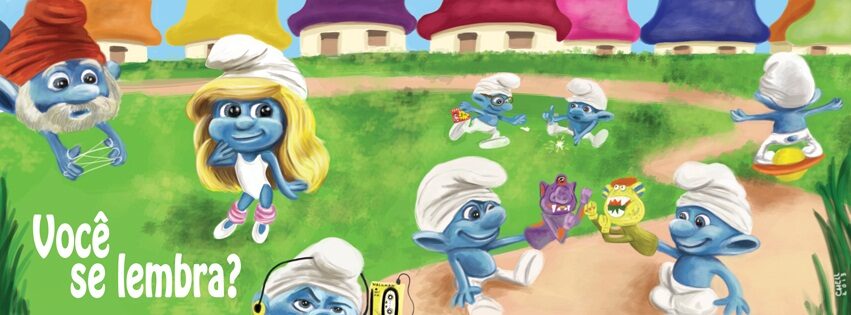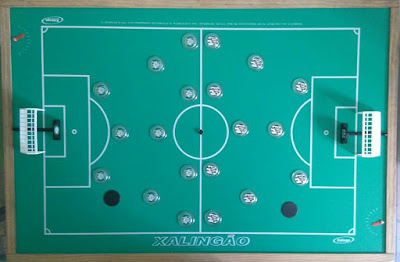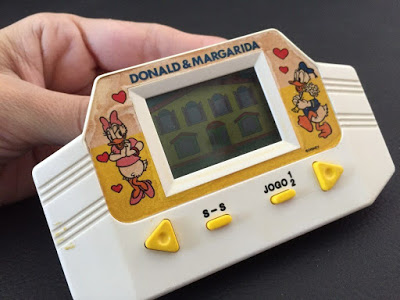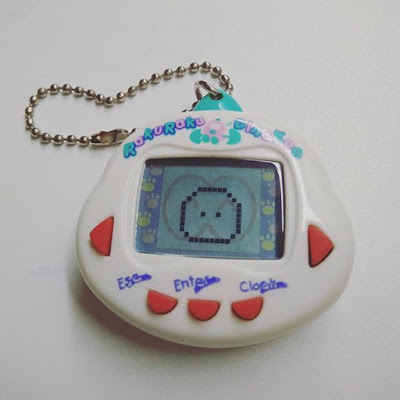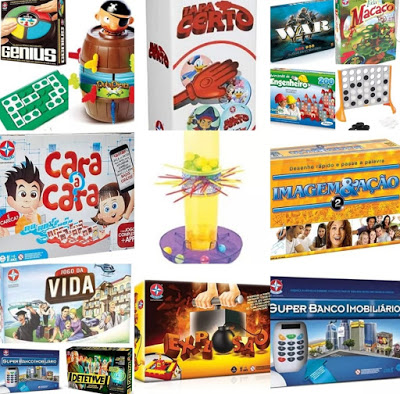Quem cresceu nos anos 80 90 no Brasil tem uma ideia dos brinquedos e jogos que mais fizeram sucesso. Mas, e no mundo todo? Ficou curioso para saber? Confira a lista exclusiva que elaboramos com o Top 30 brinquedos mais famosos do mundo nos anos 80 e 90.
Ursinhos Carinhosos
Ursinhos Carinhosos é um conjunto de personagens criado pela American Greetings em 1981 para cartões de boas-festas e de aniversário. O desenho original para os cartões foi pintado pela artista Elena Kucharik. Em 1983, a Kenner criou o primeiro de uma série de ursos de pelúcia baseados nos Ursinhos Carinhosos. Cada ursinho tem uma cor diferente e uma insígnia individual na barriga. Qual era o seu favorito?
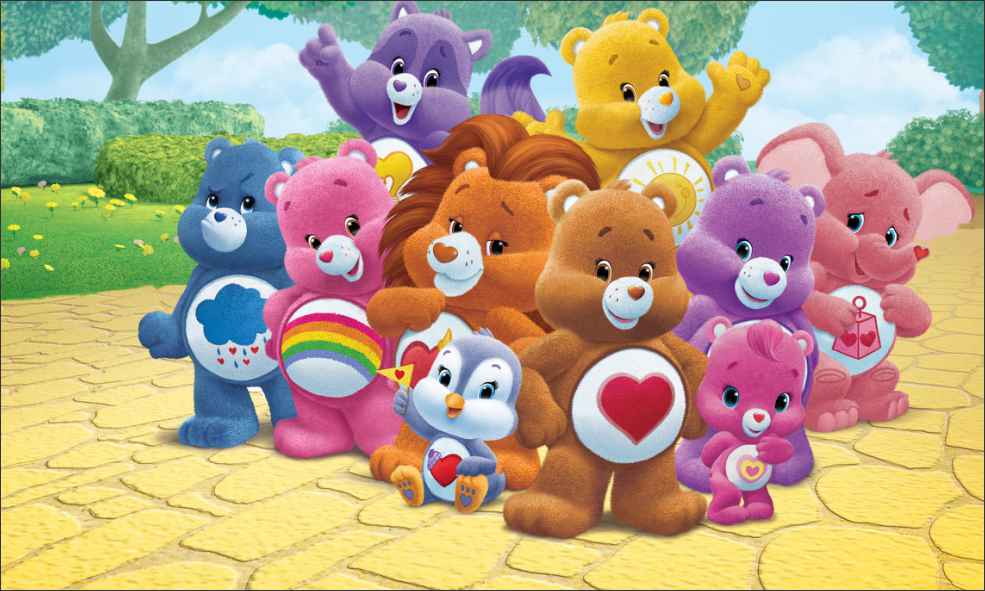 Care Bears
Care Bears
The Care Bears were every 80s girl’s favourite bear! The soft toys were originally created by an American greetings card company, American Greetings, in 1981. Then in 1982, the entire Care Bears franchise was launched in New York City and soon became one of the most popular toys amongst girls in the 1980s. By 1985, Cheer Bear, Bedtime Bear, Birthday Bear, Wish Bear, Tenderheart Bear, Good Luck Bear, Love-A-Lot Bear, Friend Bear, Funshine Bear, and Grumpy Bear were all featured in an animated television series and, by the late 1980s, also starred in three major Canadian-American movies.
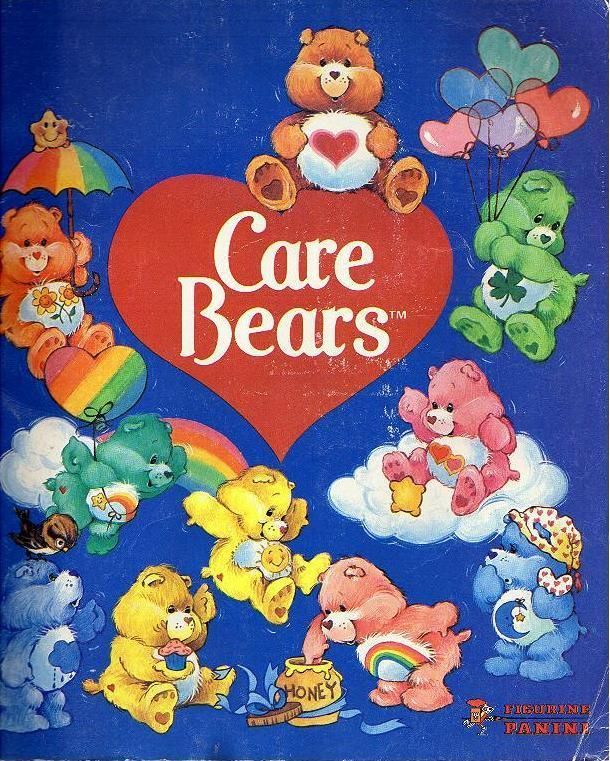
Comandos em Ação
Verdadeira febre nos anos 80 e 90, os Comandos em Ação (ou G.I. Joe, como são conhecidos nos EUA, país de origem) foram criados pela empresa de brinquedos norte-americana Hasbro e fabricados no Brasil pela Estrela. Você curtia? O que você teve da coleção?
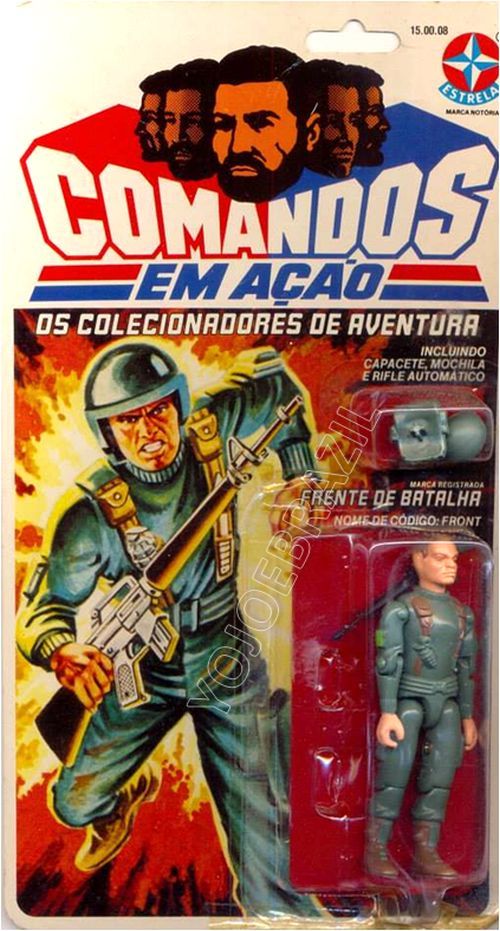
GI Joe
Hasbro created the action figures in 1964, targeting young boys. Four figures were initially launched to represent the army, the navy, the air force and the marines, and within two years, the toy was bringing in more than half of the company’s profits.
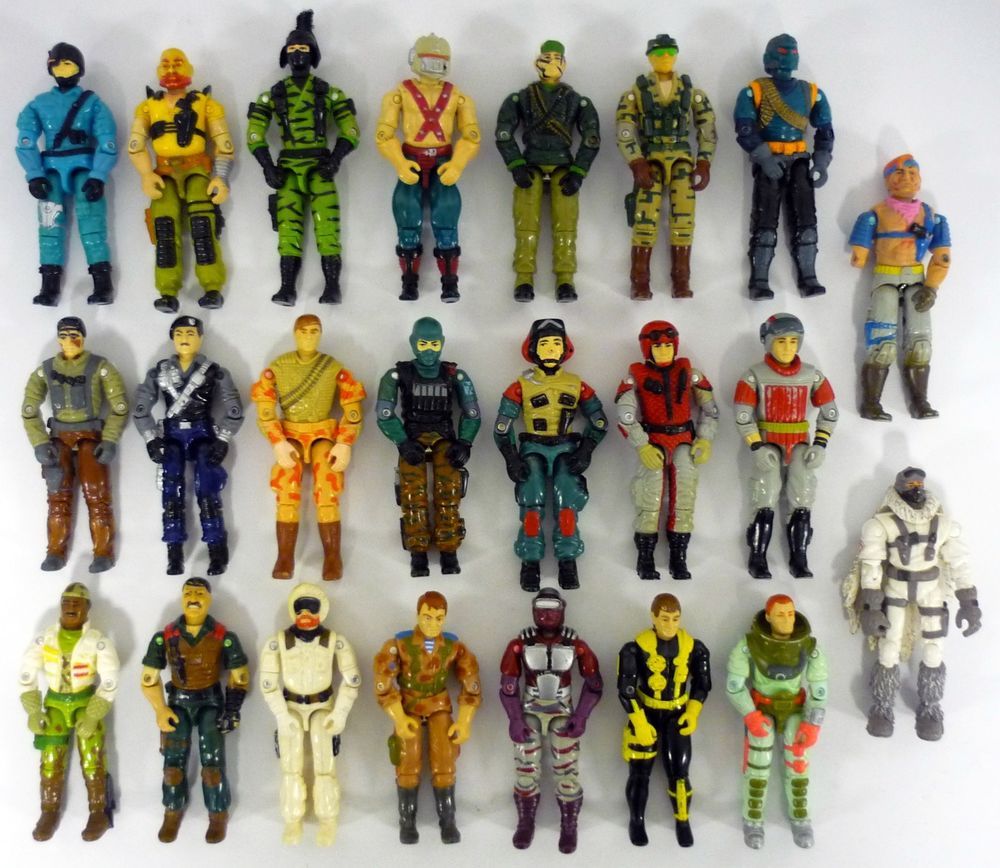 Cubo Mágico
Cubo Mágico
É um quebra-cabeça tridimensional, inventado pelo professor de arquitetura húngaro Ernő Rubik em 1974. Originalmente, foi chamado de “Cubo Mágico” pelo seu inventor, mas o nome foi alterado pela Ideal Toys para “Cubo de Rubik” quando a empresa licenciou o brinquedo em 1980. Nesse mesmo ano, ganhou o prêmio alemão do “Jogo do Ano” (Spiel des Jahres). Você sabia que Ernő Rubik demorou um mês para resolver o cubo pela primeira vez? O cubo de Rubik tornou-se um ícone da década de 1980.
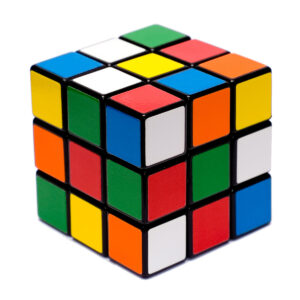
Rubik’s Cubes
The first Rubik’s Cube was made in 1974 by a college professor named Erno Rubik. Funny enough, it took Mr. Rubik a month to solve his own puzzle, and even today, only 1 in 7 people have managed to complete it! By the early 80s, 100 million Rubik’s Cubes were sold resulting in over $250 million in sales. It was hands-down one of the bestselling toys of the 80s.
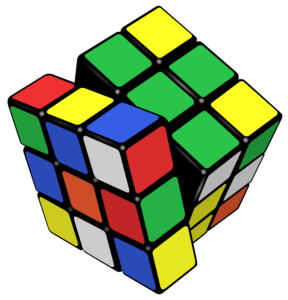 Atari
Atari
A marca Atari foi fundada por Nolan Bushnell e Ted Dabney em 1972 e seu primeiro jogo foi o arcade Pong. Em 1975, a empresa lançou uma versão caseira do jogo. Durante a década de 1970, a Atari se destacou ao produzir dezenas de jogos para arcade. Tempo depois, Nolan Bushnell vendeu a empresa para a Warner. O primeiro console foi o Atari VCS (Video Computer System), produzido em 1977. Seu preço era alto demais (em torno de 200 dólares), e uma sucessão de novos consoles foi lançado para tentar estabelecer uma fonte de renda segura, até que, em 1978, lançou o Atari 2600, de longe seu maior sucesso (e, posteriormente, o ícone da empresa).
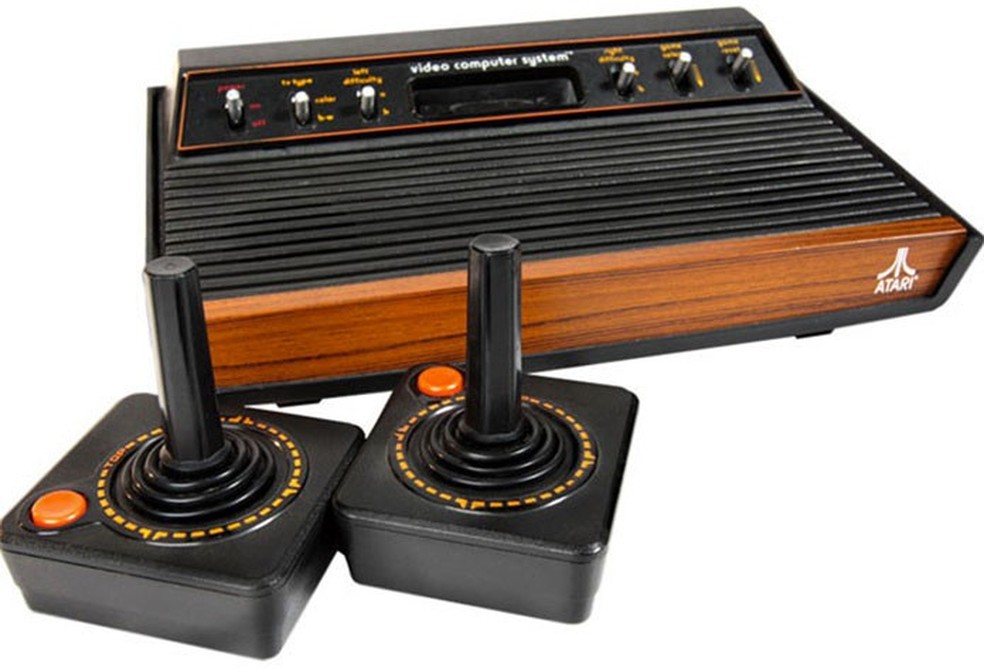 Atari
Atari
Coin-operated arcade amusement took a severe hit when Atari released the first home gaming console, which was created by the founders of the famous arcade game Pong. Atari 2600 came equipped with two joysticks, paddle controllers, a wood-panel printed console, and game cartridges, including “Space Invaders,” “Pac-Man,” and “Asteroids” sold separately. The gaming system, with normal and hard difficulty settings, sold millions, making the Atari brand a staple in many ’80s households.
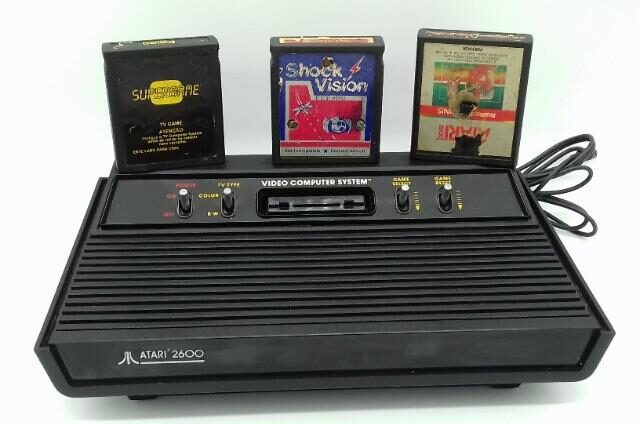
Moranguinho
Moranguinho é um personagem licenciado, atualmente de propriedade da Iconix Brand Group originalmente usado em cartões comemorativos, sendo expandida para bonecas, pôsteres e outros produtos. A marca Moranguinho também incluem uma linha de brinquedo dos amigos da personagem e seus animais de estimação. Além disso, a franquia tem gerado especiais de televisão, desenhos animados e filmes. A linha de Moranguinho de personagens cada um tinha seu próprio nome de fruta ou sobremesa temática com roupas para combinar, e cada um tinha um animal de estimação com nome de sobremesas ou frutas.
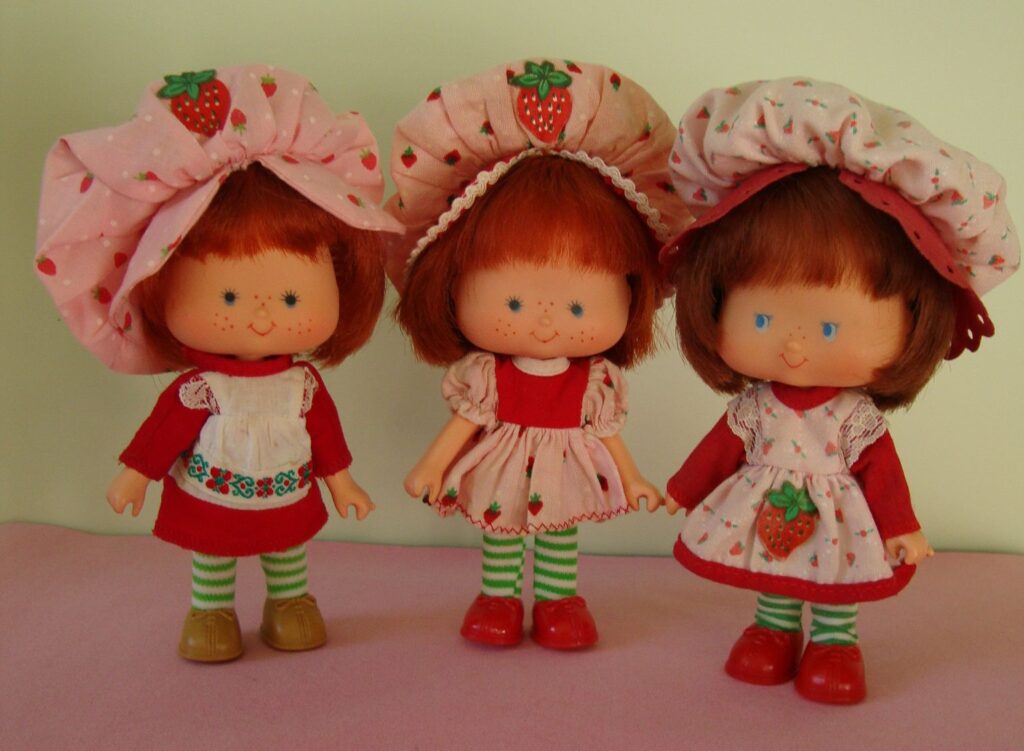
Strawberry Shortcake
Strawberry Shortcake and her sweet-smelling, dessert-themed friends like Lemon Meringue and Blueberry Muffin were all the rage for little girls in the ’80s. An animated television series, Atari video game, and memorabilia including pajamas and bedding accompanied the craze of tiny plastic figurines, which, according to character artist Muriel Fahrion, may have made a billion dollars in franchise profits. But the freckled, frumpy hat-wearing Strawberry Shortcake was more than just a toy, with Fahrion sharing on the 40th anniversary of the doll that she’s heard playing with the character created an escape for some youth who had family struggles.
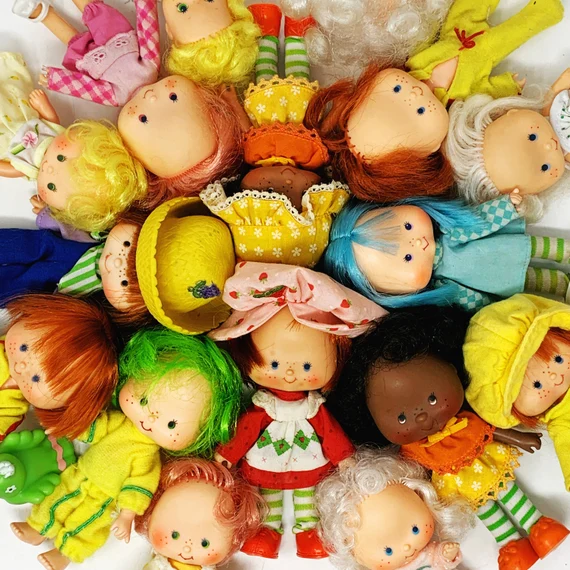
Pogobol
Febre nos anos 80 e 90, o Pogobol foi lançado pela Estrela em 1987 e logo fez o maior sucesso. Era a combinação de uma plataforma e duas bolas sobrepostas – algo como um Saturno de brinquedo.
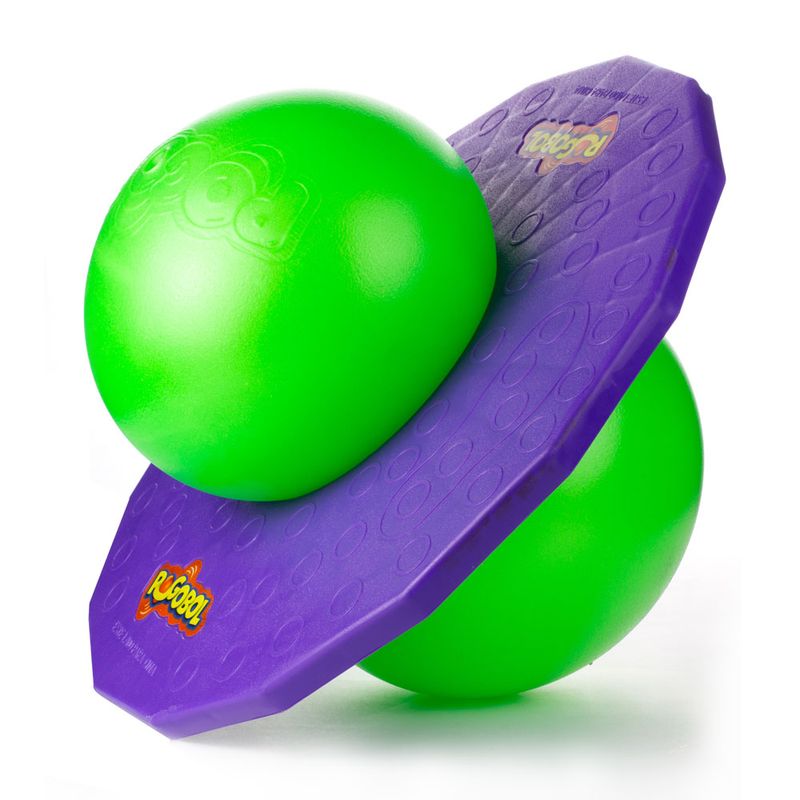
Pogo Bal
The Pogo Bal is a Saturn-looking jumping device manufactured by Hasbro and the cousin of the Pogo Stick, the latter of which is now an official extreme sport. Unlike gaining gravity with a steel coil and footpads, the inflatable ball placed in the center of a sturdy plastic circle helped kids catch air in the ’80s. After the fad’s popularity began to deflate, the use of the toy remained, with physical education teachers using it to teach balance to students and adults using it as an exercise ball.
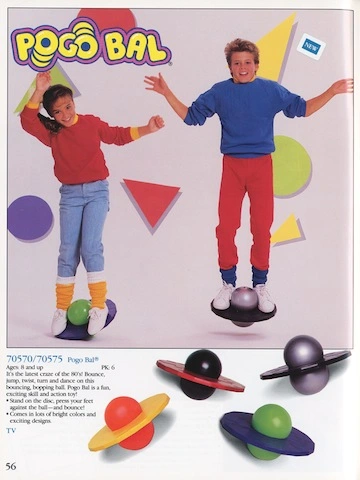
LEGO
Seu conceito se baseia em partes que se encaixam permitindo muitas combinações. Criado pelo dinamarquês Ole Kirk Kristiansen, é fabricado em escala industrial em plástico feito desde 1934. Em fevereiro de 2015, a Lego foi considerada a marca mais poderosa do mundo, de acordo com estudo realizado pela empresa de consultoria Brand Finance. O brinquedo surgiu numa pequena empresa familiar na década de 1930. Obteve sucesso na década de 1960, expandindo-se nas décadas seguintes. O criador fundiu duas palavras em dinamarquês para obter o nome “LEGO”: leg godt que significa “brincar bem”. Atualmente, o grupo LEGO emprega mais de 10.000 pessoas em cerca de 140 países, ocupando a posição de líder mundial no segmento de brinquedos para crianças nas faixas dos três meses aos dezesseis anos de idade.
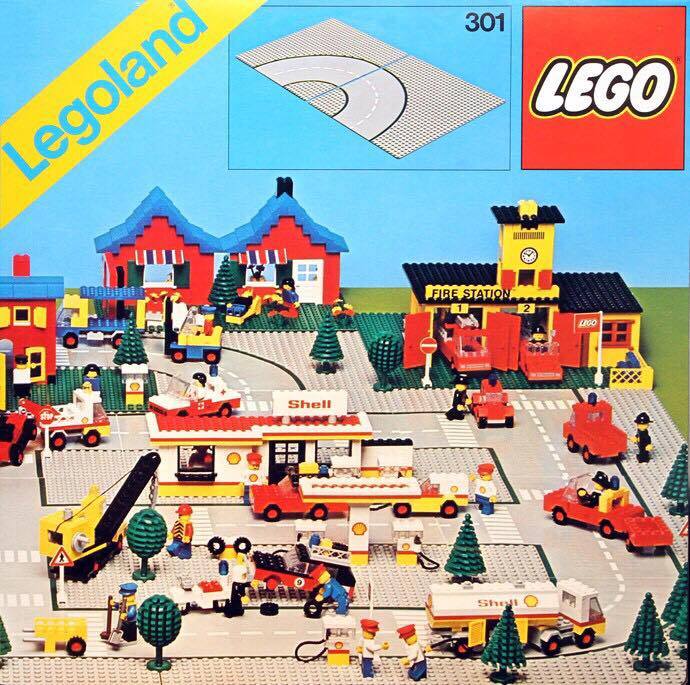
LEGO
Though Lego as we know them – small plastic bricks made to build larger toys and models – first began manufacture in Denmark in 1949, the Lego company originated as something very different. At first, Ole Kirk Christiansen’s Jutland woodworking shop produced furniture and materials to build houses, but after Christiansen’s miniature models of stepladders, ironing boards and the like – which were used as design aids – proved popular, the shop moved into making toys as well.
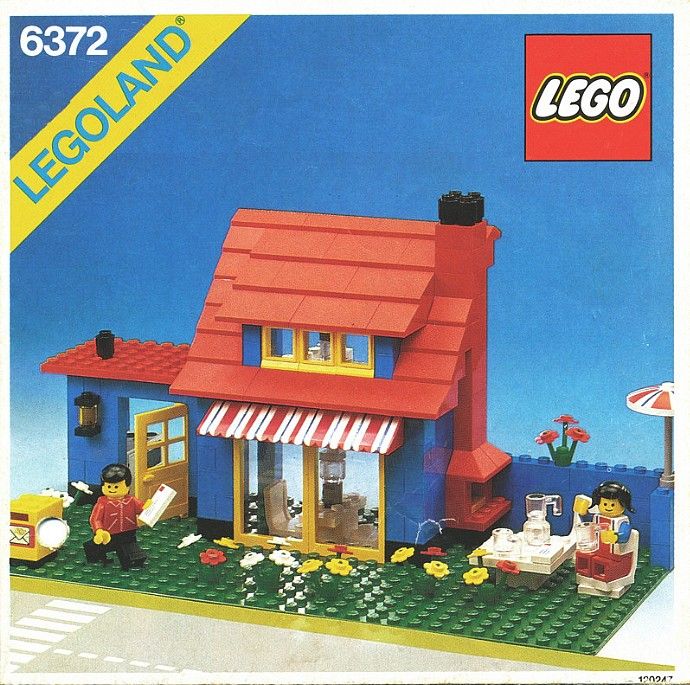
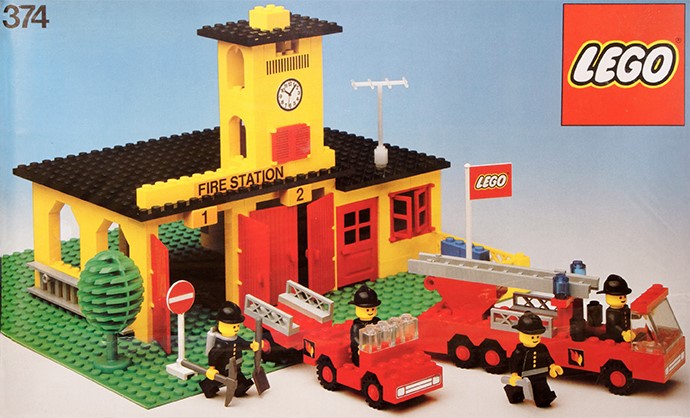 Space Legos
Space Legos
To capitalize on the success of George Lucas’ smash-hit “Star Wars,” The Lego Group, which manufactures plastic toy bricks, created minifigures with visor-less helmets and wheeled vehicles. It wasn’t until 1999 that the toy manufacturer would issue its first intellectual property license to “Star Wars,” bringing Lego and Lucas together for real—and the toy’s cultural impact remains even. to this day.
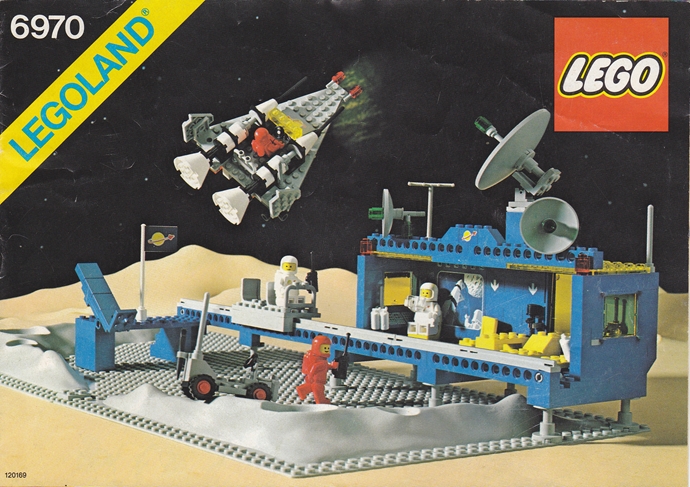
Tartarugas Ninja
As Tartarugas Ninja merecem um post especial tamanho sucesso nos anos 80 e 90. Além das histórias em quadrinhos e dos desenhos animados, as tartarugas mais famosas do mundo viraram filmes, jogos de fliperama, videogames, brinquedos, bonecos, biscoitos, álbum de figurinhas, música e até shampoo. Você também era fã?
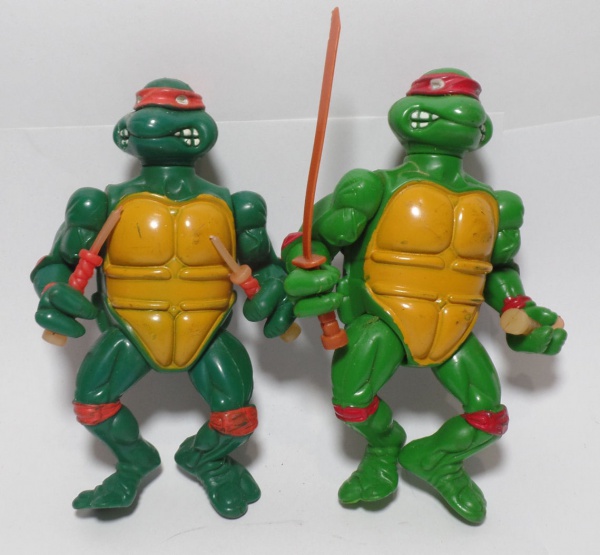
Teenage Mutant Ninja Turtles
The Italian Renaissance-named reptilians Michelangelo, Donatello, Raphael, and Leonardo are as hot now as they were in 1983 when two artists first sketched them on a piece of paper, which sold for more than $70,000 in 2012. What began as a comic book series turned into a pop-culture craze, beginning with the 1987 Saturday morning cartoon series featuring the pizza-loving martial-arts experts that was picked up by Nickelodeon in 2012. Merchandise depicting the four evil-fighting brothers totaled more than $1.1 billion in the first four years of “Turtlemania.”
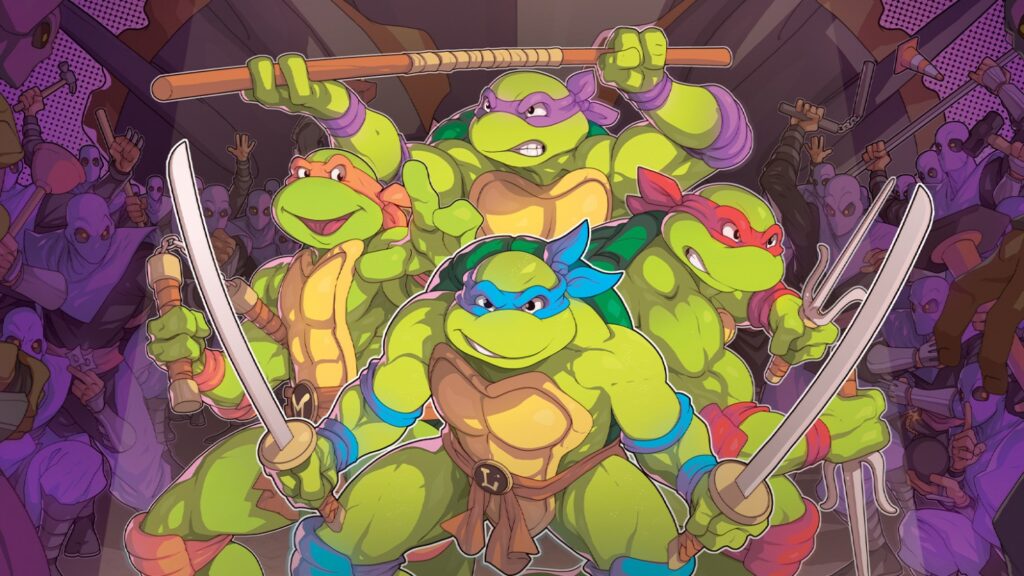
Nintendo
A década de 1970 marcou a entrada oficial da Nintendo no mercado de jogos, mas foi somente nos anos 1980 que a empresa, chefiada por Yamauchi, se consolidou no setor, após a chegada aos Estados Unidos. Especializada no desenvolvimento de jogos eletrônicos e consoles, a empresa se destacou pelo sucesso de videogames e portáteis como o NES, Nintendo 64, Game Boy, Nintendo Wii, Nintendo 3DS, etc. Além disso, a marca também é responsável pela criação e/ou publicação de jogos como “Donkey Kong”, “Super Mario Bros”, “The Legend of Zelda”, “Fire Emblem”, entre outros títulos e franquias. No Brasil, a Big N chegou em 1993 com o lançamento do NES e do Super Nintendo.
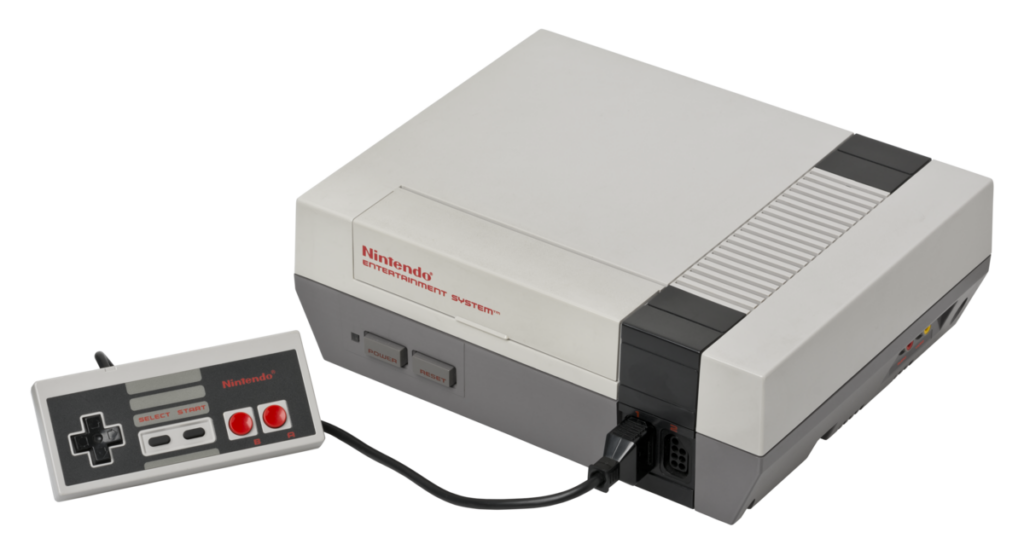 Nintendo
Nintendo
Nintendo was founded in 1889 as Nintendo Karuta by craftsman Fusajiro Yamauchi and originally produced handmade hanafuda playing cards. After venturing into various lines of business during the 1960s and acquiring a legal status as a public company, Nintendo distributed its first console, the Color TV-Game, in 1977. It gained international recognition with the release of Donkey Kong in 1981 and the Nintendo Entertainment System and Super Mario Bros. in 1985. Since then, Nintendo has produced some of the most successful consoles in the video game industry, such as the Game Boy, the Super Nintendo Entertainment System, the Nintendo DS, the Wii, and the Switch. It has created numerous major franchises, including Mario, Donkey Kong, The Legend of Zelda, Pokémon, Kirby, Metroid, Fire Emblem, Animal Crossing, Splatoon, Star Fox, Xenoblade Chronicles, and Super Smash Bros. Nintendo’s mascot, Mario, is internationally recognized. The company has sold more than 5.4 billion video games and over 800 million hardware units globally as of 2022.
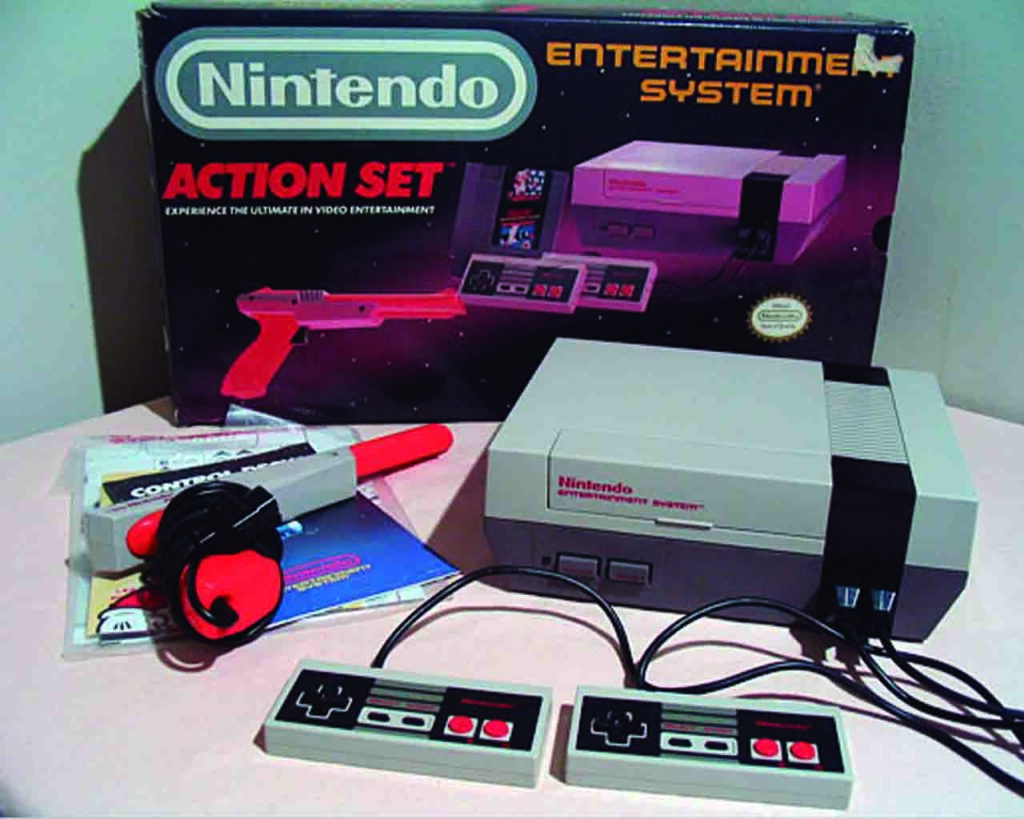 Fluffy
Fluffy
Febre nos anos 90, as bolas de borracha peludas, famosas Fluffy, serviam de “bola” para variados jogos até “Ioiô”. A que mais me marcou foi a bicolor, verde e amarela. Algumas tinham carinha e bracinhos. Vocês se lembram / tiveram?
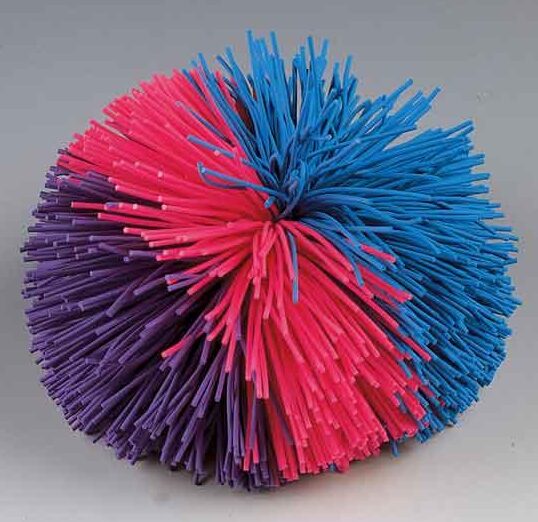
Koosh Ball
The Koosh ball, made up of approximately 2,000 natural rubber filaments, was invented by an engineer who wanted to make playing catch more simple and safe for his children. After only a few years after the 1986 invention, Archie Comics picked up the idea, publishing a short series based on six living Koosh balls. The toy line, which also produced key chains and yo-yos, saw controversy when Supreme Court Justice Ruth Bader Ginsburg was asked to rule on its copyrightability in 1993, and a woman sued after being hit with one on the “Rosie O’Donnell Show” in 2003.
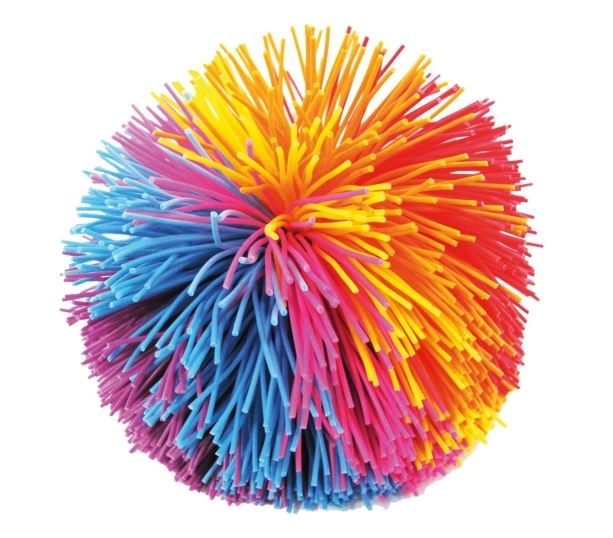
Furby
Quem tem mais de 30 anos provavelmente se lembra do Furby. Ele foi lançado pela Hasbro nos anos 1990, na forma de um bichinho felpudo que interagia com os usuários. Em 2013, a empresa relançou o gadget, mas agora com diversas novas funções: sensores de movimento, aprendizado espontâneo, interação com smartphones, entre outras coisas.
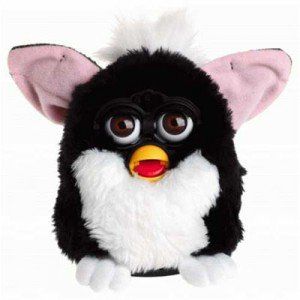 The Furby
The Furby
The Furby was one of the most bestselling toys of the 90s. This digital pet was introduced in 1998 from Tiger Electronics and was programmed with 800 words and phrases. It also had blinking eyes that would totally freak you out if you accidentally came across it in the dark. Despite its scary Gremlins-inspired appearance, 1.8 million Furbies sold in the first year resulting in about $14 million in sales. There is still a collector’s market for the Furby to this day.
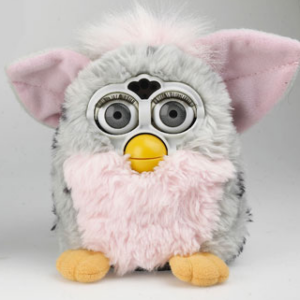
Tamagotchi
O Tamagotchi é uma franquia de mídia japonesa, distribuída pela Bandai e criada por Akihiro Yokoi e Aki Maita. O primeiro lançamento da franquia foi um brinquedo em que se cria um animal de estimação virtual lançado em 1996. A motivação do brinquedo consiste em cuidar do animalzinho virtual como se fosse real, dando-lhe carinho virtual, comida virtual, banho virtual, cuidados virtuais etc.
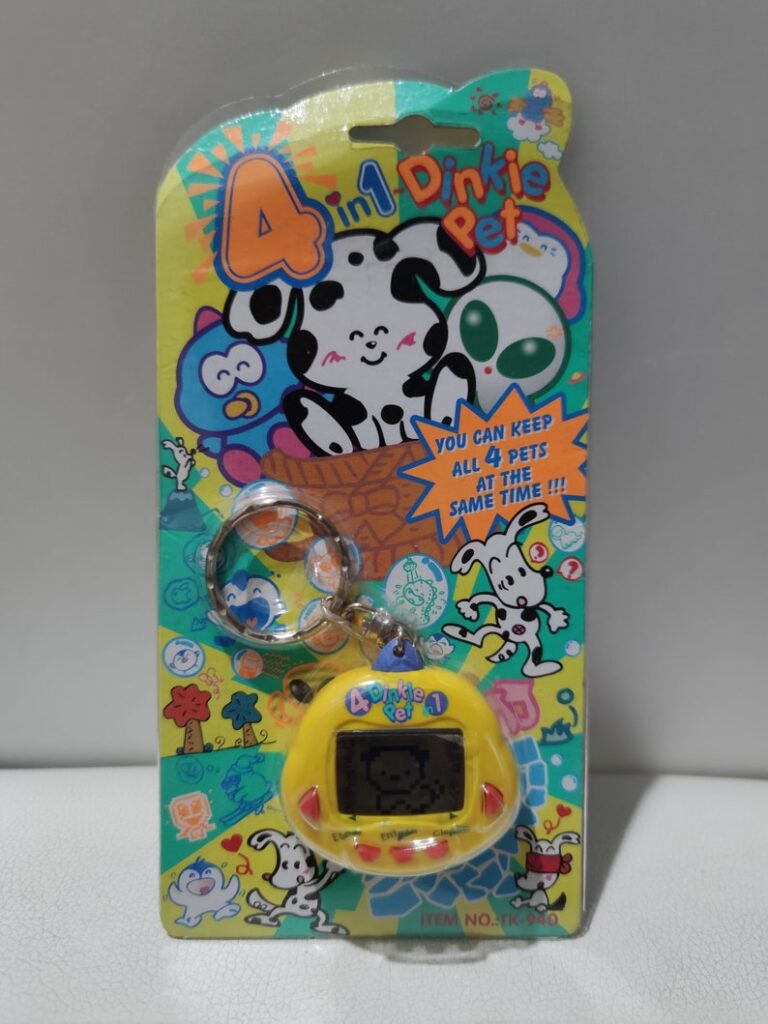 Tamagotchi
Tamagotchi
A Tamagotchi is a virtual pet on a keychain that first came out in 1996. It was created by a Japanese toy company named Bandai who eventually moved it overseas to sell in Europe and the United States. Demand for the Tamagotchi was so insane, people were camping outside overnight in front of stores to buy one. These digital keychains were literally everywhere – Happy Meal toys, TV shows, books, and on the shelves in every retail store imaginable. 5 million Tamagotchi keychains sold in the first year, and eventually 80 million sold by the end of the 90s.
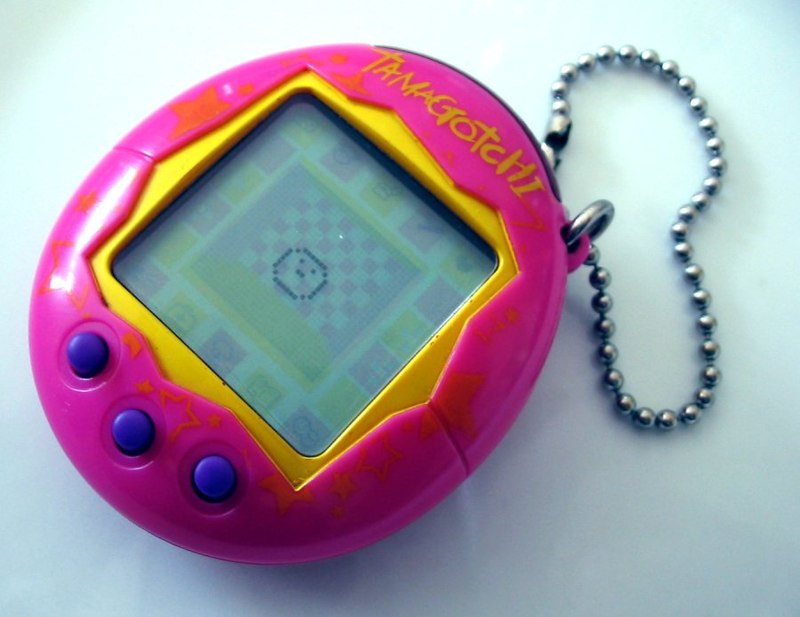
Meu Pequeno Pônei / Meu Querido Pônei
Meu Pequeno Pônei ou Meu Querido Pônei foi uma série de desenho animado baseada na franquia homônima produzida entre os anos de 1986 e 1987 pela Sunbow Productions e Marvel. No Brasil, a série foi exibida na Rede Globo, nos programas Xou da Xuxa e TV Colosso em 1987. Como outros desenhos da época, logo surgiu uma linha de bonecos inspirados nos cavalinhos, que tinham como característica longas crinas, cores variadas e uma marca traseira que identificava cada um.
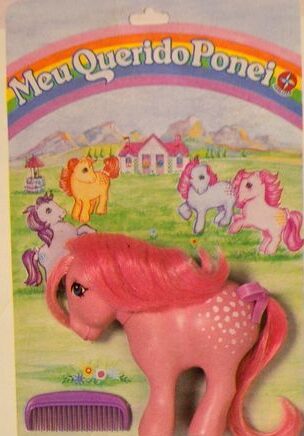 My Little Pony
My Little Pony
My Little Pony galloped into every kid’s heart when the line of toys came out in 1982. Released by Hasbro, these mini ponies came with beautiful rainbow colored hair that 80s girls couldn’t resist brushing and braiding. Today, My Little Pony has totally crossed over gender lines with a community of hipster boys who also love the toys. They call themselves “Bronies,” and there are viral videos of them cherishing their favorite horses. Who knows how many of them helped with the $1 billion in sales that My Little Pony earned in 2014 alone?!
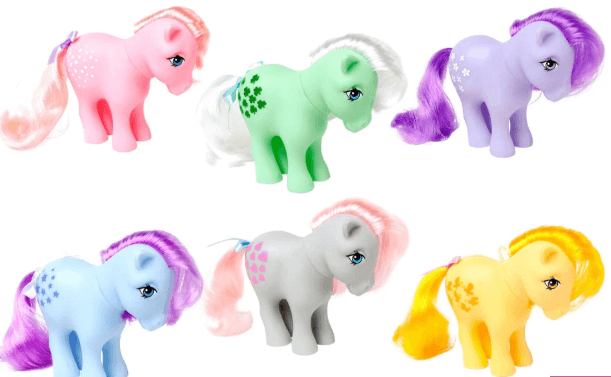
Snif Snif
Um dos cachorrinhos mais famosos dos anos 80. Você teve? De qual cor? O Snif Snif foi lançado pela Estrela em 1985 e o slogan era “o cachorrinho que precisa de colinho”. O bichinho vinha acompanhado de um “Certificado de Propriedade”.
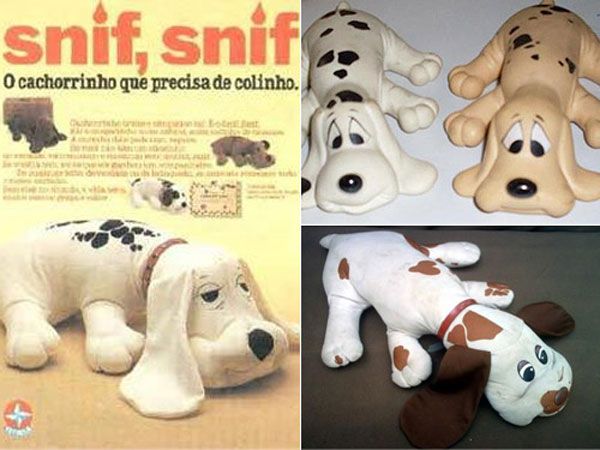
Pound Puppies
Pound Puppies were the perfect compromise between children begging for a family dog and parents that didn’t want to pick up after a dog. They came in a cardboard rescue crate for “adoption,” with adorable eyes and big floppy ears for $30 (and an additional $3.50 for name tag). Inventor Mike Bowling, who showed the product to 14 companies before one bit, estimated in 2016 that there were three times as many Pound Puppies in the U.S. than actual dogs.
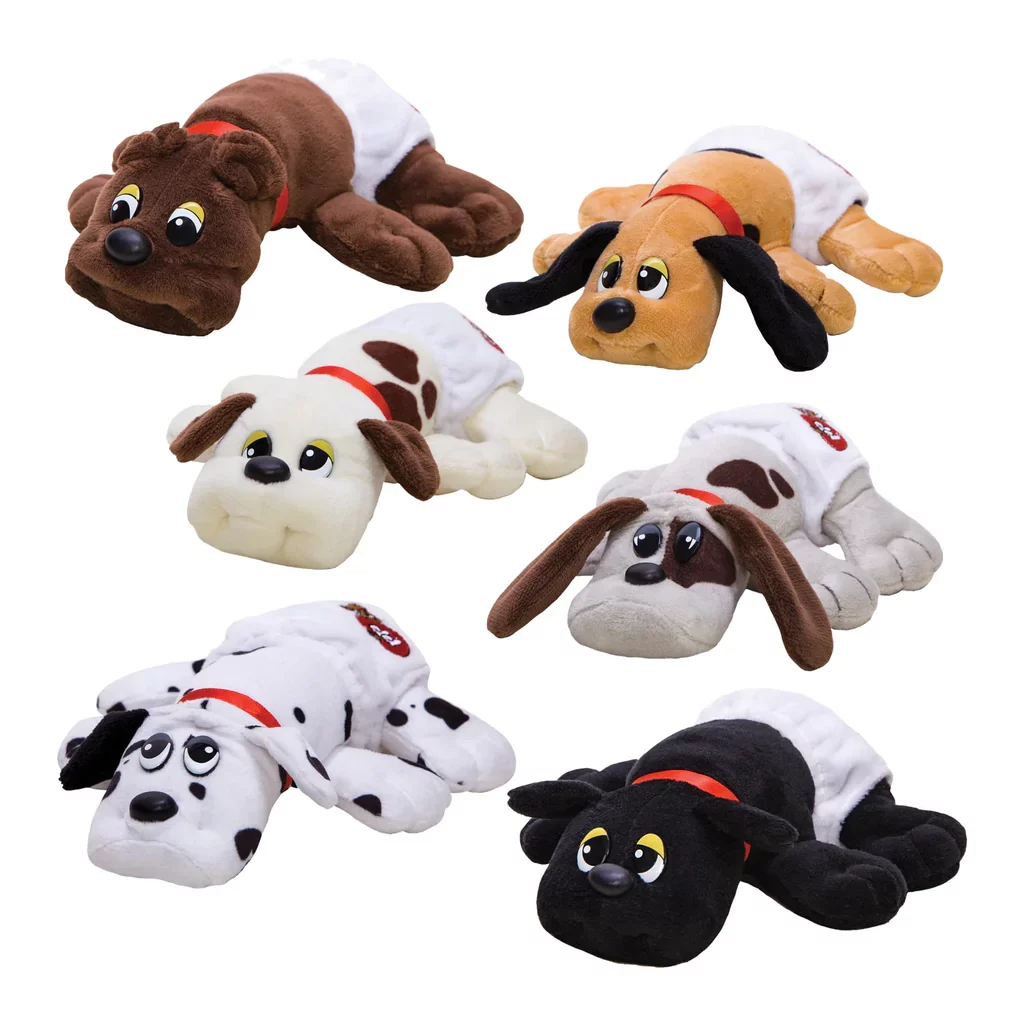
Polly Pocket
Polly Pocket é uma franquia de brinquedos femininos desenvolvida pela Bluebird desde 1989. A série foi originalmente baseada numa boneca pequena e portátil de bolso. Depois de alguns anos a boneca ficou maior, tornando-se uma fashion doll ao estilo da Barbie e Susi. O auge do sucesso da boneca foi ainda maior durante os anos 2000, quando a personagem passou a render sua própria linha de produtos como filmes, livros, materiais escolares e jogos eletrônicos chegando a quase alcançar o mesmo nível de sucesso da Barbie, principalmente na América Latina.
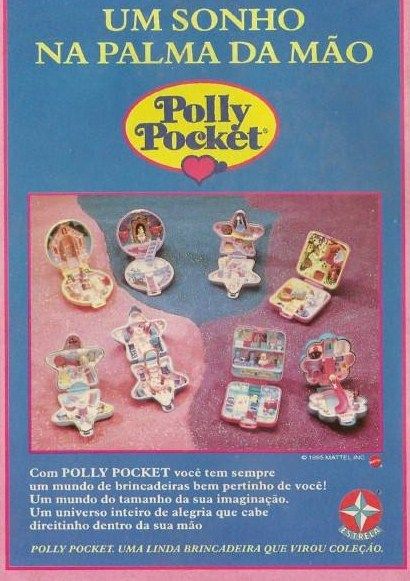 Polly Pocket
Polly Pocket
Polly Pockets, which premiered in 1989, were a staple for young kids who could mix and match the tiny dolls with many tiny accessories. Created in 1983 by Chris Wiggs for his daughter, his original set used a powder compact as a tiny house. Polly Pockets were licensed by Mattel in the 1990s before the company bought Bluebird Toys in 1998. Polly got a new life after returning from a three-year hiatus in 2018.
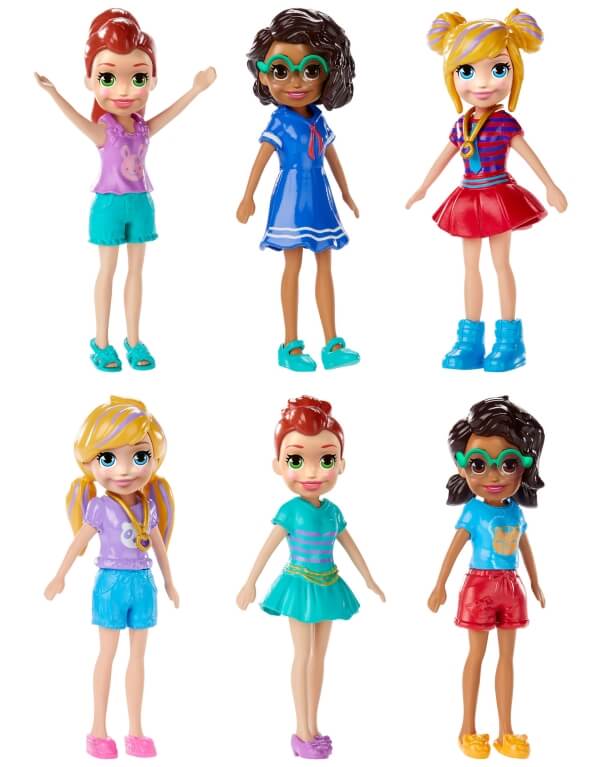
He-Man, She-Ra e Castelo Grayskull
He-Man é o personagem principal da linha de brinquedos Masters of the Universe da Mattel, presente em uma série de histórias em quadrinhos e várias séries animadas, caracterizadas pela sua força sobre-humana. Na maioria das variações, ele é o alter ego do Príncipe Adam. He-Man e seus amigos tentam defender o reino de Eternia e os segredos de Castelo de Grayskull das forças do mal de Esqueleto.
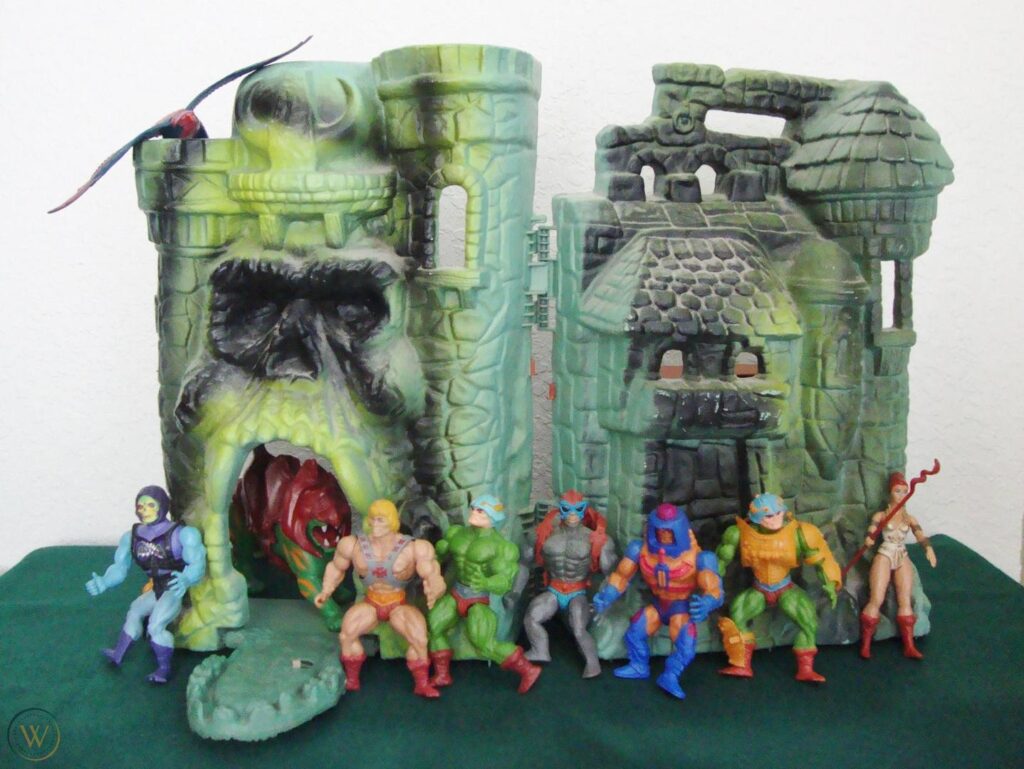
He-Man, She-Ra and Castle Grayskull
By the power of Grayskull, He-Man and the Masters of the Universe action figures were on many Christmas lists when Mattel debuted the line in 1982. Following the exploits of He-Man and his fight against Skeletor, Masters of the Universe’s 70 original action figures spawned comic books, television shows, movies, a She-Ra spin-off, and eight video games. Mattel answered calls from fans of the ’80s hit and released a new Masters of the Universe Origins collection, beginning in 2020 with He-Man and Skeletor.
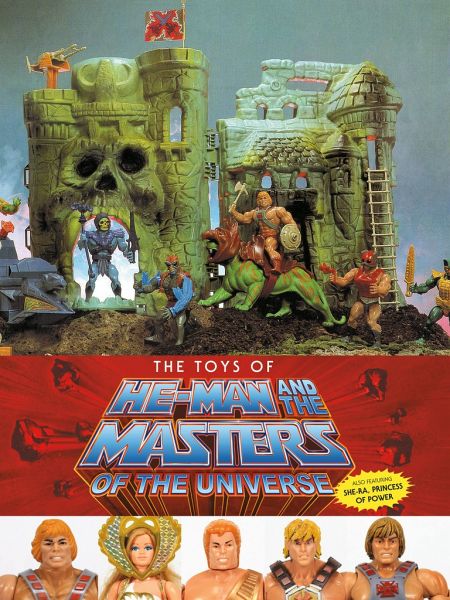
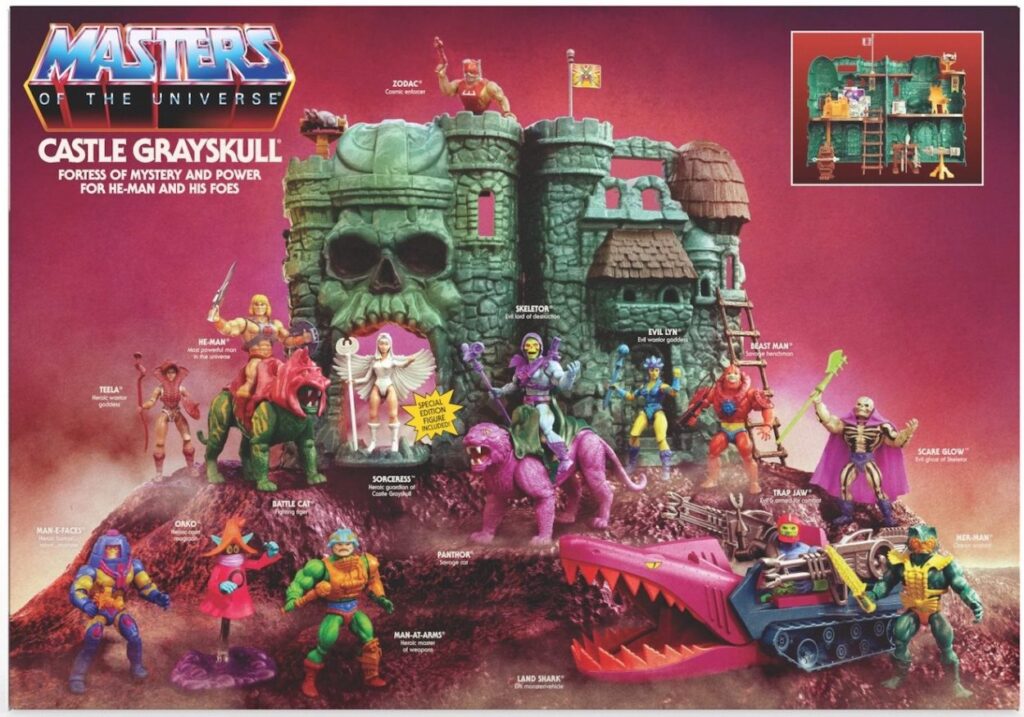
Monchhichi
Monchhichi é uma linha de brinquedos para macacos de pelúcia japoneses da Sekiguchi Corporation, lançada pela primeira vez em 1974. Eles foram licenciados pela Mattel nos Estados Unidos até 1985 e, posteriormente, distribuídos mundialmente diretamente pela Sekiguchi.
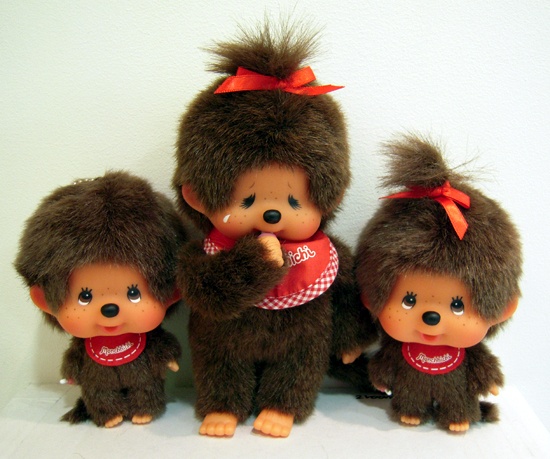 Monchhichi
Monchhichi
The catchy jingle that went along with Monchhichi helped draw kids to these stuffed monkey toys. The Japanese company Sekiguchi released the doll, which could suck its thumb, in 1974, and it reached the U.S. in 1980 under a licensing deal with Mattel. The dolls spawned a Saturday morning cartoon series from Hanna-Barbera in 1983, before the fad began to wear off and Mattel dropped the line in 1985, which Sekiguchi rereleased in 2004.
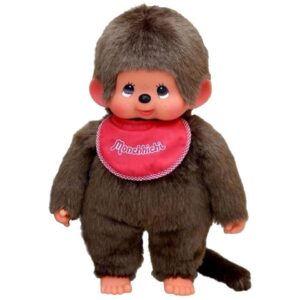
Rainbow Brite
Rainbow Brite é uma franquia de mídia criada pela Hallmark Cards em 1995. A série animada homônima começou sua emissão em 1996. No Brasil, foi emitida pelo SBT no programa Do Ré Mi Fá Sol Lá Simony. O sucesso foi tanto que virou brinquedos, bonecos, álbuns, livros, etc.
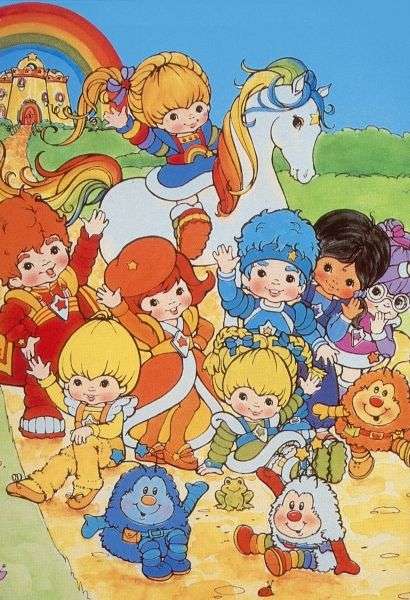 Rainbow Brite
Rainbow Brite
Hallmark Cards introduced Rainbow Brite—who brought happiness and color wherever she went—as an animated series in 1984. Mattel took the reigns for merchandising, and the Rainbow Brite dolls, with their vibrant hair, along with her trusted steed Starlite, became must-have toys for young girls. Rainbow Brite was Mattel’s most successful product to that point, spawning multiple movies, books, TV shows, and more, with a marketing budget of $35 million in 1985.
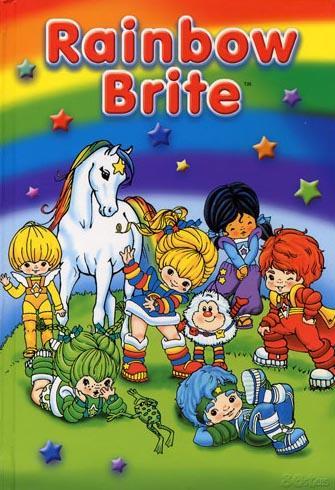
Teddy Ruxpin
O Teddy Ruxpin foi originalmente criado pelo inventor norte-americano Ken Forsse e lançado no mercado em 1985, e como é de se imaginar, encantou as crianças dos EUA, sendo um dos brinquedos mais populares no final dos anos 80. A Tectoy adquiriu os direitos do ursinho falador em 88 e repetiu o sucesso do seu país de origem, com fitas que vinham junto com livrinhos de histórias e aventuras que Teddy lia para a criançada.
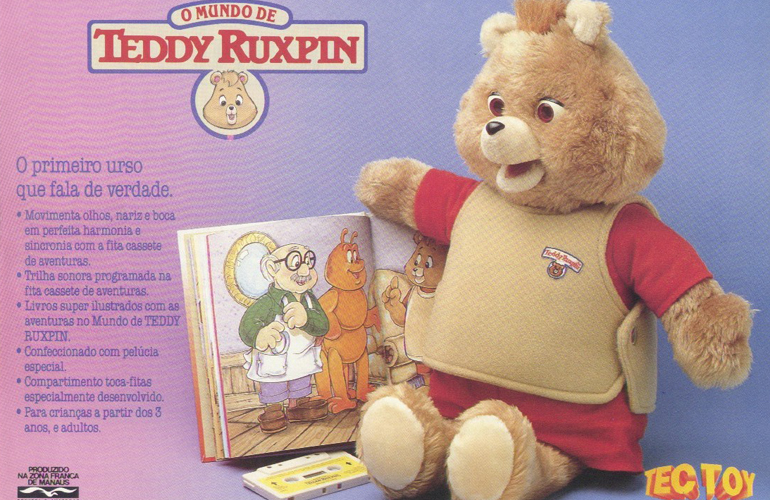
Teddy Ruxpin
Teddy Ruxpin captured the attention of boys and girls everywhere, as his ability to talk and move both his eyes and mouth were revolutionary at the time. Teddy would read stories to kids thanks to a cassette tape inserted in his back and was so popular, Worlds of Wonder had to charter jets from China, Hong Kong, and Taiwan stuffed with Teddy Ruxpins to try to meet demand. While the original Teddy Ruxpin is a collector’s item, newer versions with LCD eyes and a slew of new stories to tell would hit the shelves in 2017.
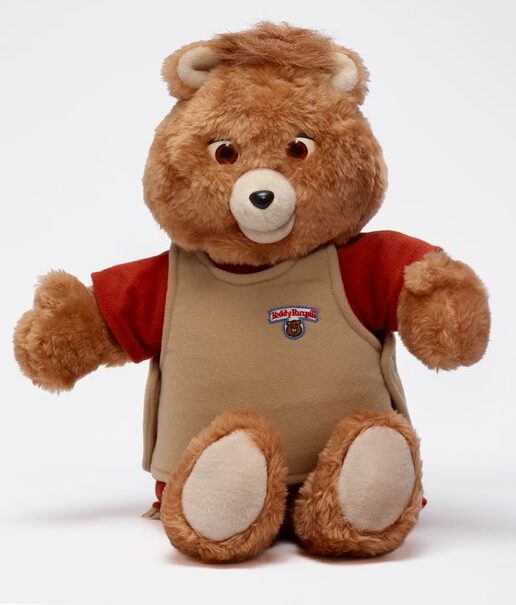
Boneca Repolho
Aqui no Brasil, as bonecas “Cabbage Patch Kids” (“bonecas repolho ou pimpolho”), de 1983, também fizeram muito sucesso. O atrativo das bonecas era sua individualidade. Não existiam duas exatamente iguais; cada boneca tinha uma diferente cor de olhos, traços faciais, cabelos, etc. Originalmente criadas artesanalmente pela artista Martha Nelson Thomas como uma expressão de amor para os brinquedos e crianças, durante as festas de final de ano de 1983, 3 milhões de bonecas repolho foram vendidas.
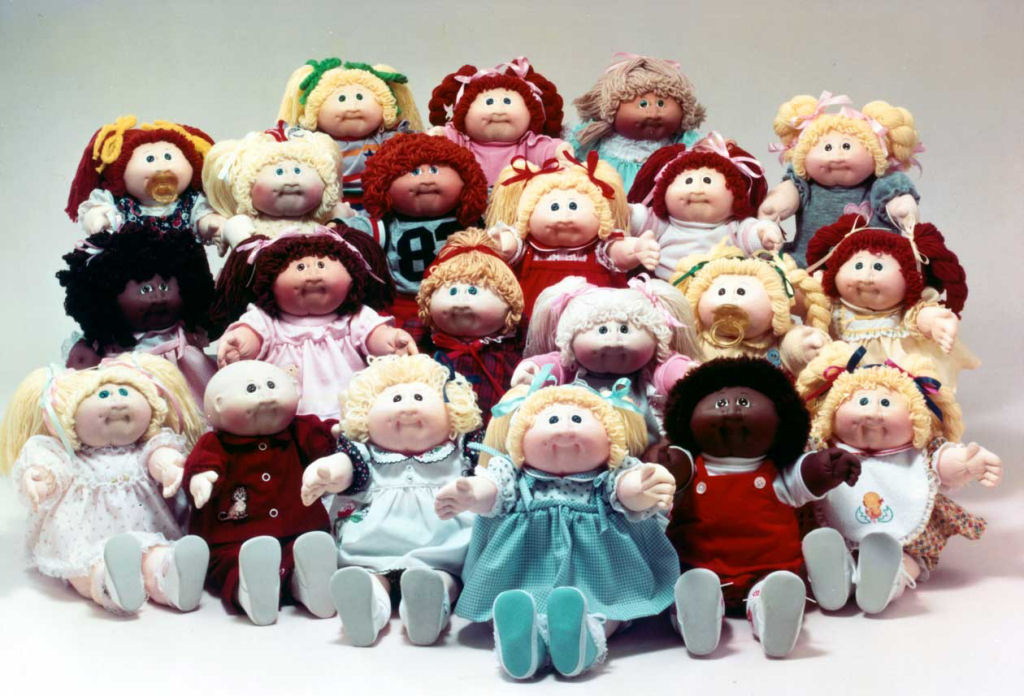
Cabbage Patch Kids Doll
Cabbage Patch Kids dolls were one of the most popular toys in the 1980s, generating nearly $2 billion in sales during the decade. The huggable dolls, of which no two were alike, came with a birth certificate, and were so sought after that consumers rioted across the country when supplies ran out before Christmas in 1983. The original Cabbage Patch Kids dolls weren’t made for consumers, but were the creation of Kentucky artist Martha Nelson Thomas, who would adopt them out to her friends, before her idea was stolen.
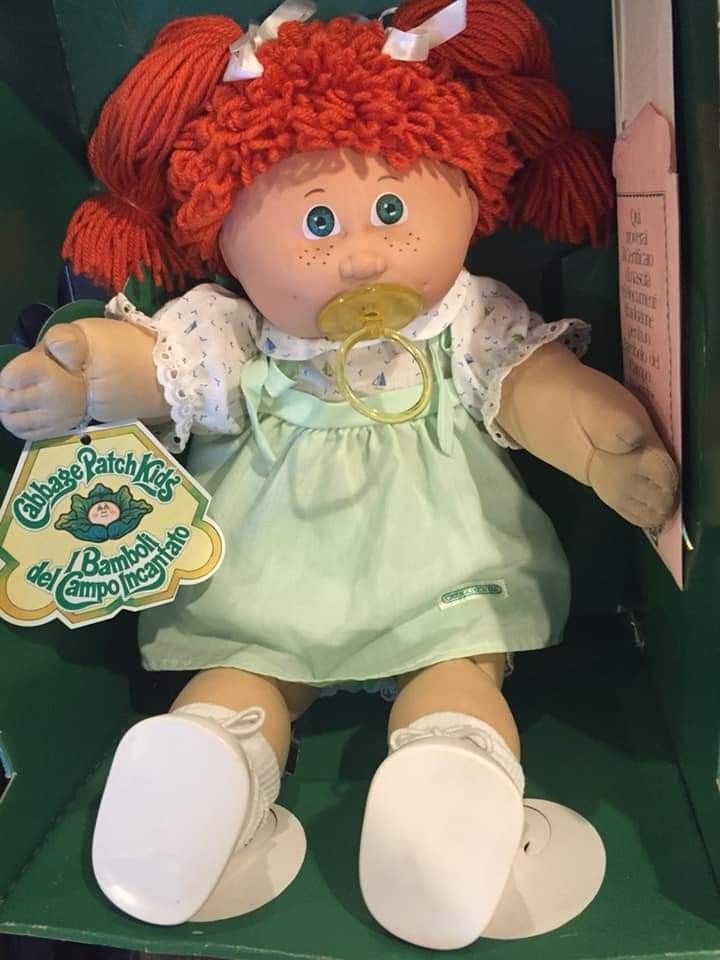
Transformers
Encomendada pela empresa americana Hasbro para divulgar sua nova linha de brinquedos, o desenho Transformers foi lançado em 1984, roteirizado pelos norte-americanos e animado pela japonesa Toei Animation.
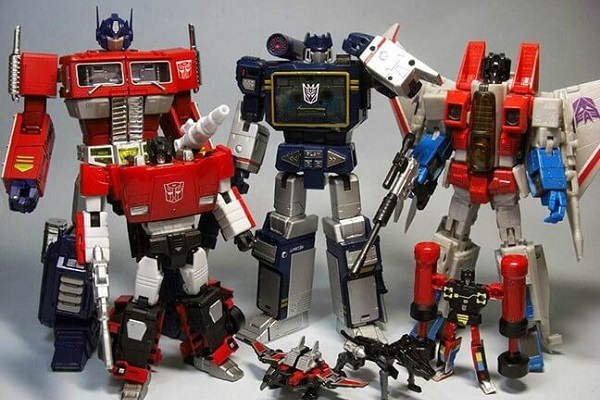
Transformers
Transformers were released by Hasbro in 1984. The first generation included 18 Autobots and 10 Decepticons, which transformed into either cars, or as was the case for Optimus Prime, semi-tractor trailers. These shape-shifting toys were so popular, an animated show was created in the same decade. Now Transformers are bigger than ever thanks to the 7 blockbuster movies that have been released since 1986. These movies have made close to $5 billion combined at the worldwide box office. The success of the Transformers franchise proves just how much people love these robots in disguise!
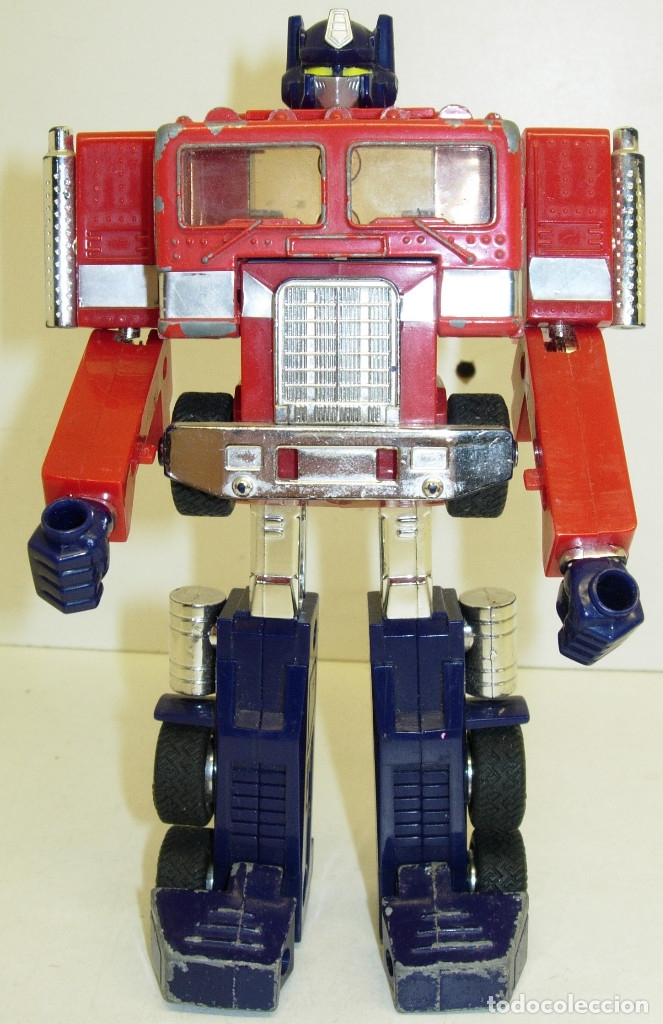
Genius
O Genius lançado em 1980 pela Estrela foi o primeiro jogo eletrônico vendido no Brasil, sendo a versão do Simon, do fabricante americano Hasbro. O Genius original possuía três jogos diferentes e quatro níveis de dificuldade.Voltou a ser fabricado pela Estrela em 2012.
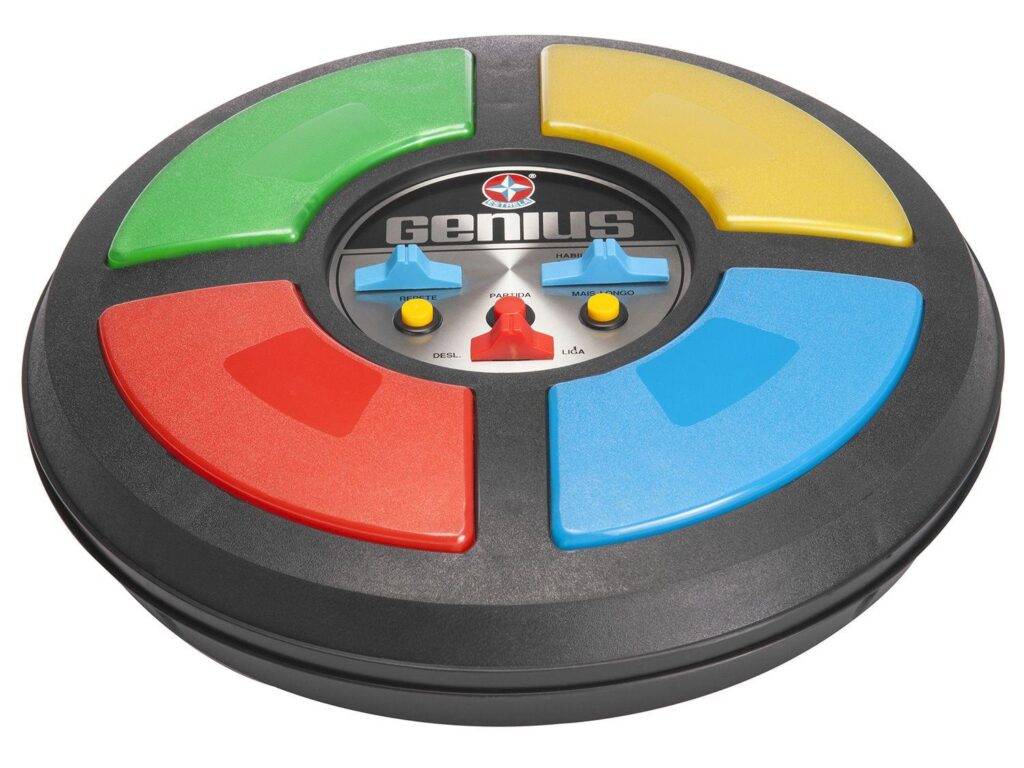 Simon
Simon
Milton Bradley inspired a phenomenon when it launched the deceptively simple Simon console at New York’s Studio 54 in 1978. Simon, which sold for the equivalent of $96, was designed as both a single- and multi-player memory game that required users to press four colored buttons while repeating an increasingly longer sequence of lights and sounds. The simplicity of the original Simon inspired multiple generations of the game, including the Simon Optix, a wearable headset that flashes lights before the user’s eyes.
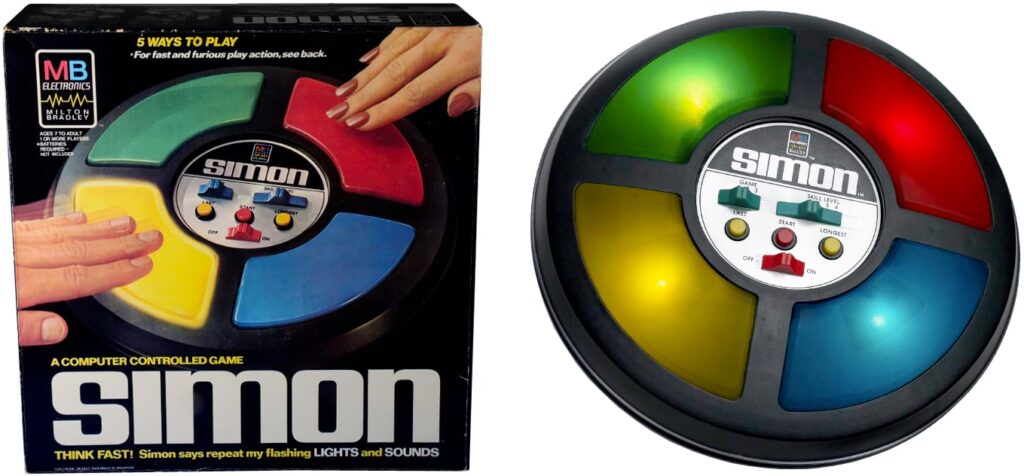
Game Boy
O Game Boy é um console portátil desenvolvido pela Nintendo, lançado em 21 de abril de 1989 no Japão, em 31 de julho de 1989 na América do Norte e em 28 de setembro de 1990 na Europa, é o primeiro console da linha Game Boy, foi criado por Gunpei Yokoi e pela Nintendo Research & Development 1, versões redesenhadas do console foram lançadas em 1996 e em 1998, o Game Boy Pocket e o Game Boy Light (somente para o Japão). O Game Boy é o segundo portátil da Nintendo, criado após a linha Game & Watch lançada em 1980.
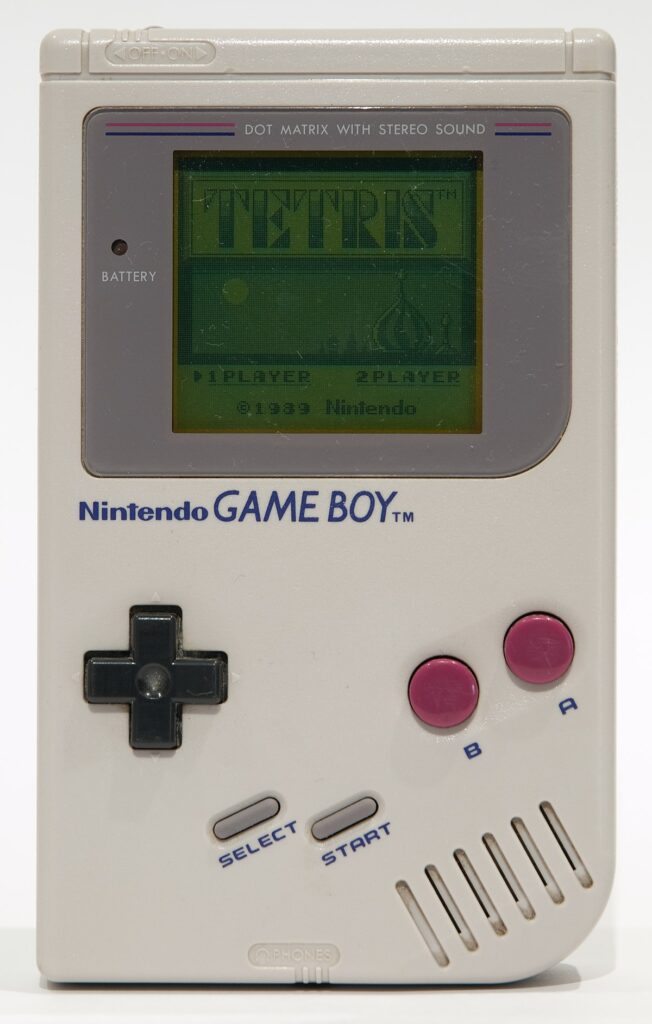 Game Boy
Game Boy
The Game Boy was Nintendo’s second venture into handheld video gaming, and it found immediate success by selling over 1 million units within weeks of its 1989 release. The small gaming system, which came packaged with the wildly popular Tetris, combined elements from Nintendo’s NES gaming console and the Game and Watch, the original 1980 handheld from the Japanese company. Although it was less advanced than competitors from Sega and Atari, the 30 hours of battery life started a craze that has sold over 110 million units.
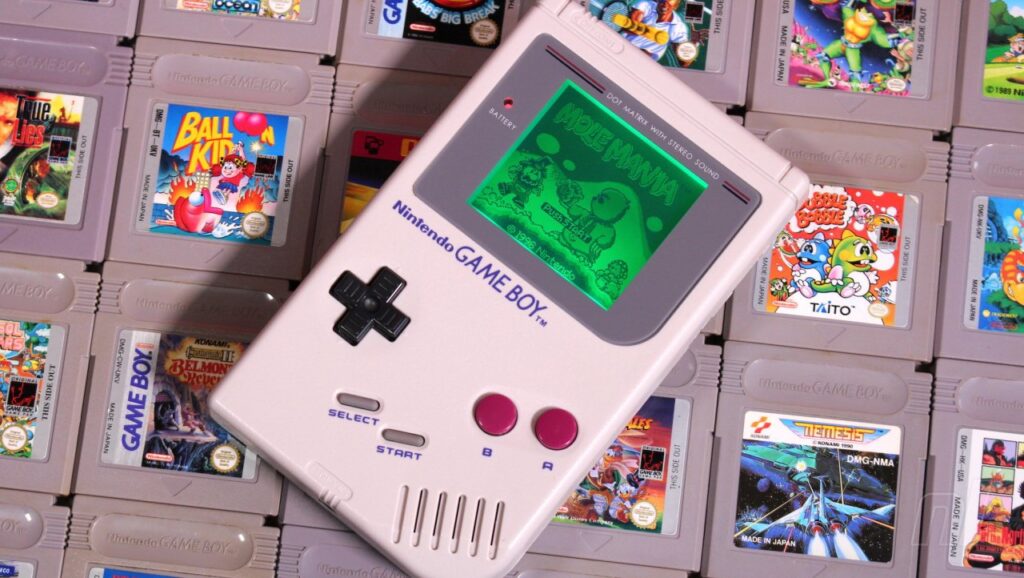
Os Smurfs
Os Smurfs é uma série de desenho animado americana-belga, produzido pela Hanna-Barbera e criado pelo cartunista Peyo. No Brasil, a série foi transmitida pela Rede Globo na década de 1980 nos programas infantis como Balão Mágico e Xou da Xuxa. Foi transmitido também pelo SBT e pela RedeTV! no final dos anos 90. O sucesso foi tanto que virou brinquedos, álbuns, livros, roupas, etc.
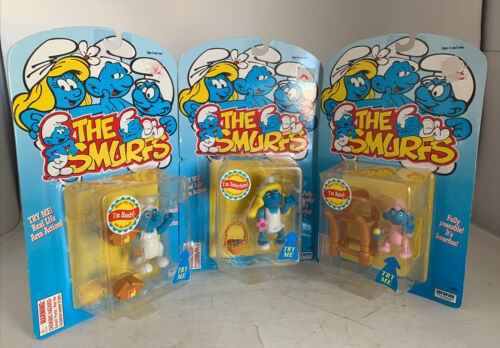
It was almost impossible to ignore the Smurfs in the 1980s, as what began as a 1960s Belgian comic evolved into action figures, a popular television show, video games, countless stuffed animals, and even a macabre UNICEF commercial. There were dozens and dozens of action figures to collect, from Papa Smurf to the Smurfs’ peace-loving nemesis, Gargamel, some of which can fetch over $100 today. Two major motion pictures in the past decade have helped bring a resurgence for the Smurfs in the U.S., while steady interest in Belgium has helped lead to over 400 figurines in the collection.
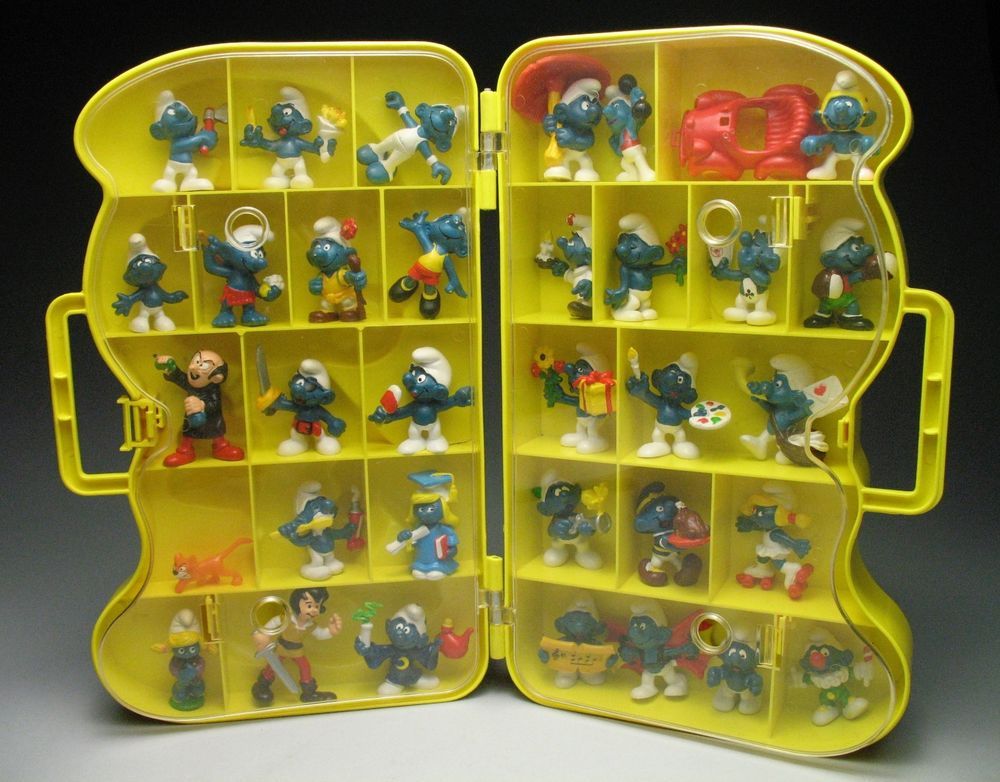
Star Wars / Guerra nas Estrelas
Star Wars / Guerra nas Estrelas é uma franquia do tipo space opera americana criada pelo cineasta George Lucas, que conta com uma série de nove filmes de fantasia científica e dois spin-offs. O primeiro filme foi lançado apenas com o título Star Wars, em 25 de maio de 1977, e tornou-se um fenômeno mundial inesperado de cultura popular, sendo responsável pelo início da “era dos blockbusters”, que são superproduções cinematográficas que fazem sucesso nas bilheterias e viram franquias com brinquedos, jogos, livros, etc.
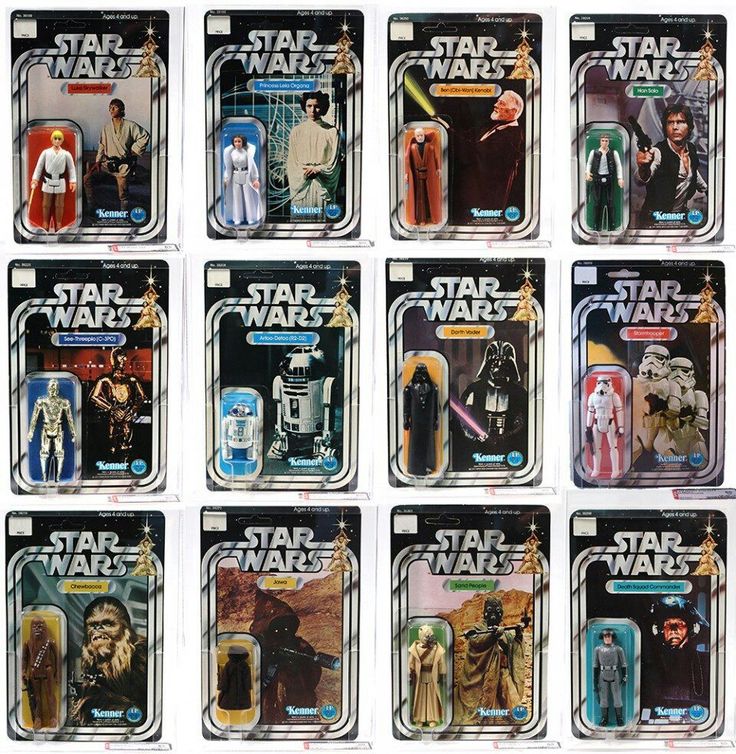
Star Wars Figurines
Kenner released the first “Star Wars” figures in 1978: Luke Skywalker, Princess Leia, Chewbacca, and R2D2. They continued to release figures until 1985, and it wasn’t until 10 years later that new figures were released when Hasbro began to manufacture the toy series. The demand for vintage “Star Wars” figures hasn’t faltered much: In 2017, a rare “Star Wars” Jawa action figure sold for £21,600 (equivalent to $28,000). And in the 1980s prototype for Bib Fortuna (from “Return of the Jedi”) was purchased for £36,000 (equivalent to more than $46,000) in 2019.
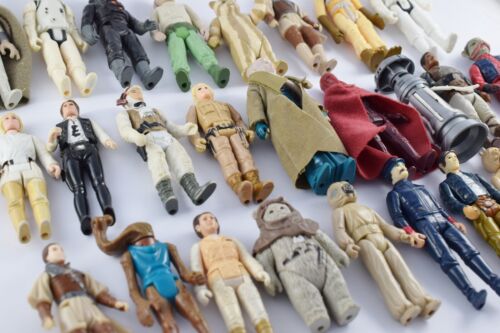
Jogo Hipopótamo
Esse jogo era o máximo! Cada jogador (até quatro) tinha que pegar o maior número de bolas que conseguisse com o respetivo hipopótamo, que abria e fechava a boca com a ajuda de uma alavanca. Os quatro hipopótamos do jogo original, comercializado em 1978, tinham até nomes: Lizzie (roxo), Henry (laranja), Homer (verde) e Harry (amarelo).
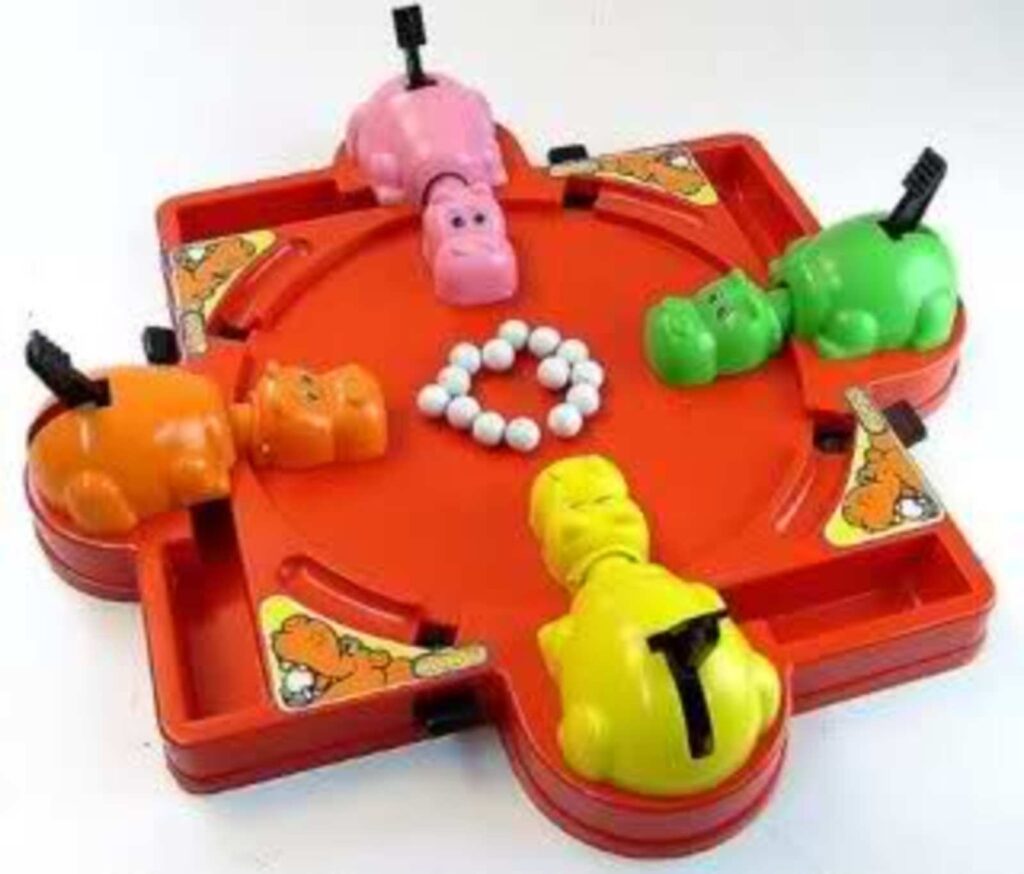
Hungry Hungry Hippos
Hungry Hungry Hippos came out in 1978 from Milton Bradley and went on to become one of the most popular 80s games of all time. It is designed for 2 to 4 players, with the objective being to gobble up the most white marbles. The best 80s toys inspired movies and shows, and while the Hungry Hippos didn’t necessarily have that kind of influence on the zeitgeist, they were still extremely popular. There’s even a Guinness World Record for the fastest game ever played. A man named Axel Tuanzebe managed to eat all 20 marbles in 17.37 seconds!
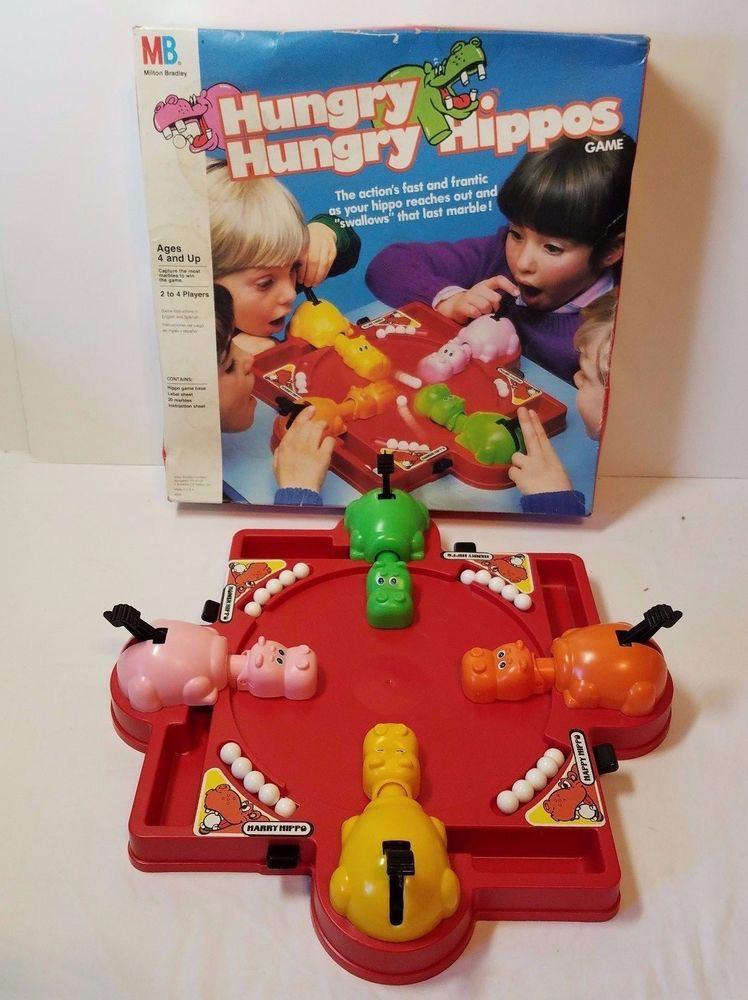
Barbie
Sem dúvidas, a boneca mais famosa do mundo! Acredito que ganhar uma Barbie, o carro, a casa, a loja, a piscina e tudo mais da coleção era o sonho de grande parte das meninas nos anos 80 e 90. Lembro que brincar de Barbie era a minha brincadeira favorita, passava horas arrumando todo o cenário e criando histórias mirabolantes com a Barbie, o Ken, o Bob, a Skipper… Meu sonho era ter a casa da Barbie, mas acabei me conformando com a piscina, a lojinha, e alguns móveis da casa. E você? Gostava da Barbie? O que você teve e mais gostava da coleção?
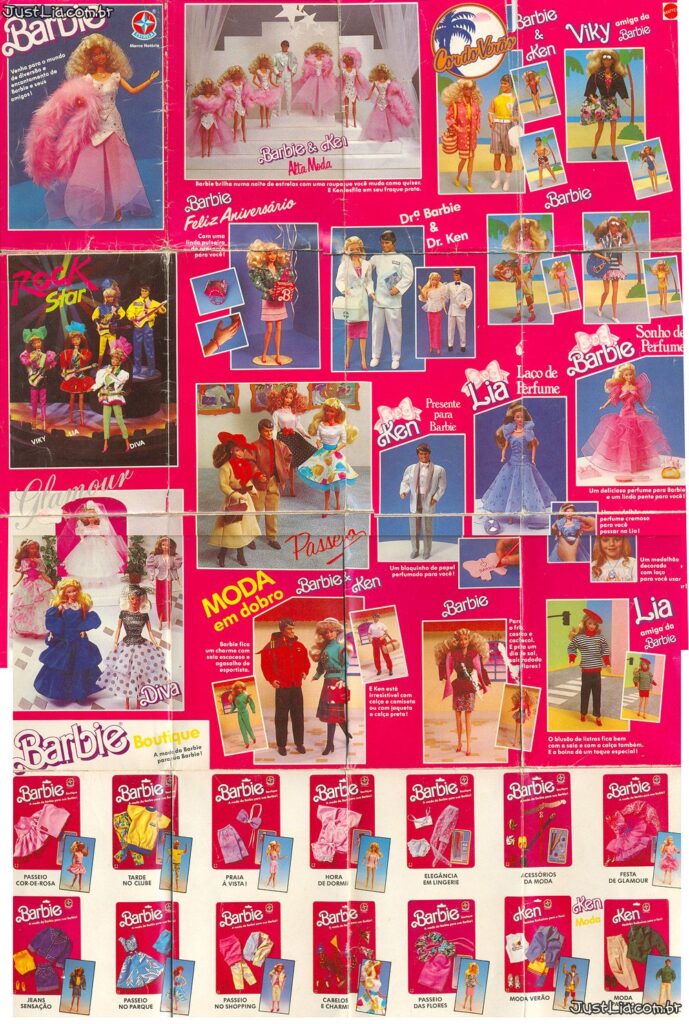
Barbie
Barbie is a fashion doll created by businesswoman Ruth Handler and produced by Mattel, Inc since 1959. Inspired by a German line of adult-bodied fashion dolls named Bild Lilli – initially, these were made for adults, but eventually Lilli became popular with children – Handler sought to make an adult doll that her pre-teen daughter, Barbara, would be interested in playing with. At the time, the dolls that were marketed towards children largely were made to resemble infants. Seeing a gap in the market, Handler took her idea to husband Elliot Handler and his business partner Harold Matson, who together owned Mattel, Inc. Mattel had been founded by Matson and the Handlers in 1945, having started out selling picture frames and, later, dollhouse furniture.
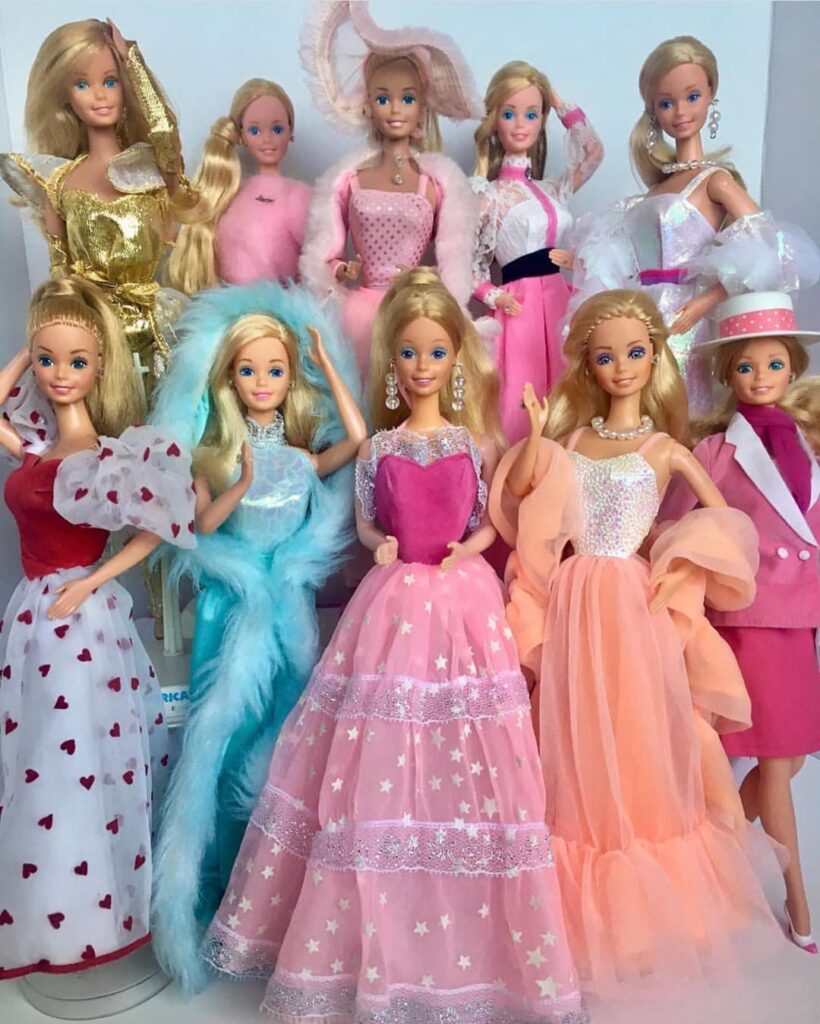 Traço Mágico
Traço Mágico
O Traço Mágico é um brinquedo de desenho mecânico inventado pelo francês André Cassagnes e subsequentemente fabricado pela empresa americana Ohio Art Company. O brinquedo é composto por uma tela plana cinza numa moldura plástica vermelha, com dois botões giratórios nos cantos inferiores da moldura. Ao se girarem os botões uma stylus espalha pó de alumínio no fundo da tela, deixando uma linha sólida. Os botões criam imagens lineográficas: o esquerdo move a stylus horizontalmente, e o direito a move na vertical. O Etch A Sketch foi lançado no auge do Baby Boom em 12 de julho de 1960, e é um dos brinquedos mais conhecidos daquela época. Em 1998, foi indicado ao National Toy Hall of Fame em Rochester, New York. Em 2003, a Toy Industry Association nomeou o Etch A Sketch como um dos 100 brinquedos mais memoráveis e mais criativos do século 20.
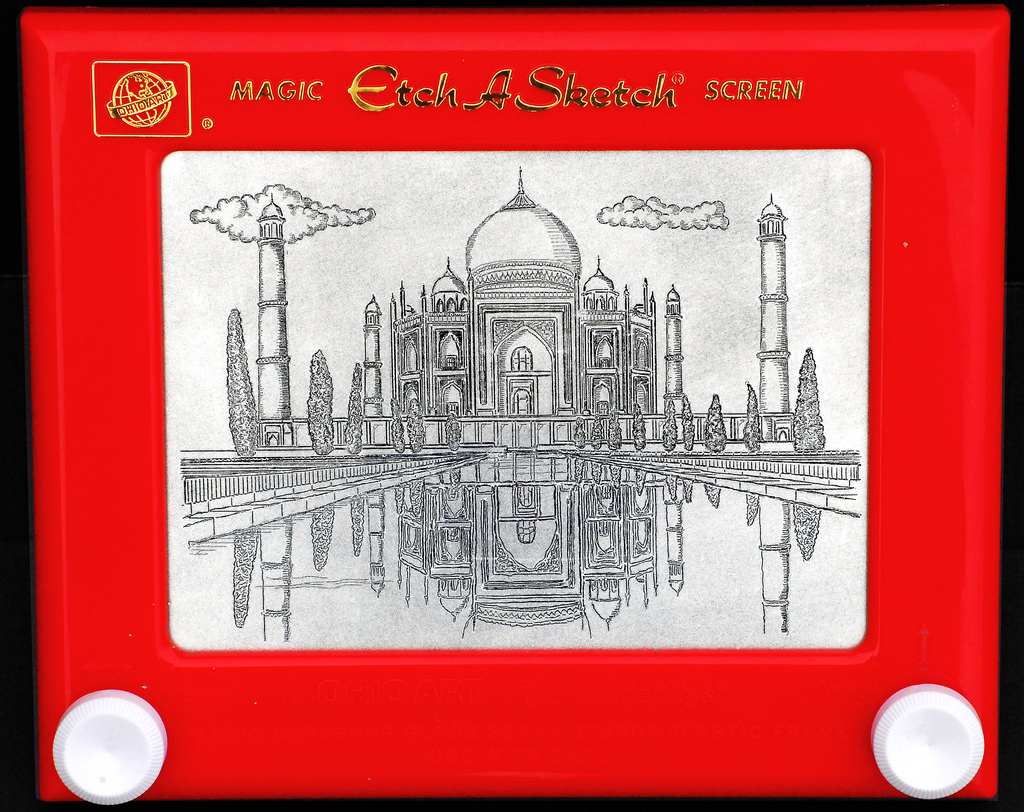
Etch a Sketch
The Etch a Sketch is another toy in the National Toy Hall of Fame. It was invented in 1960 by an electrical technician named André Cassagnes who eventually sold the rights to Ohio Art. The Etch a Sketch really became famous in the mid-90s due to an updated look that included sparkly frames and pocket-sized travel versions. It may be an old-school toy, but more than 175 million Etch a Sketches have sold since the toy was first released. It’s even been on the big and small screen in movies like Elf and TV shows like ‘Pretty Liar Liars.”
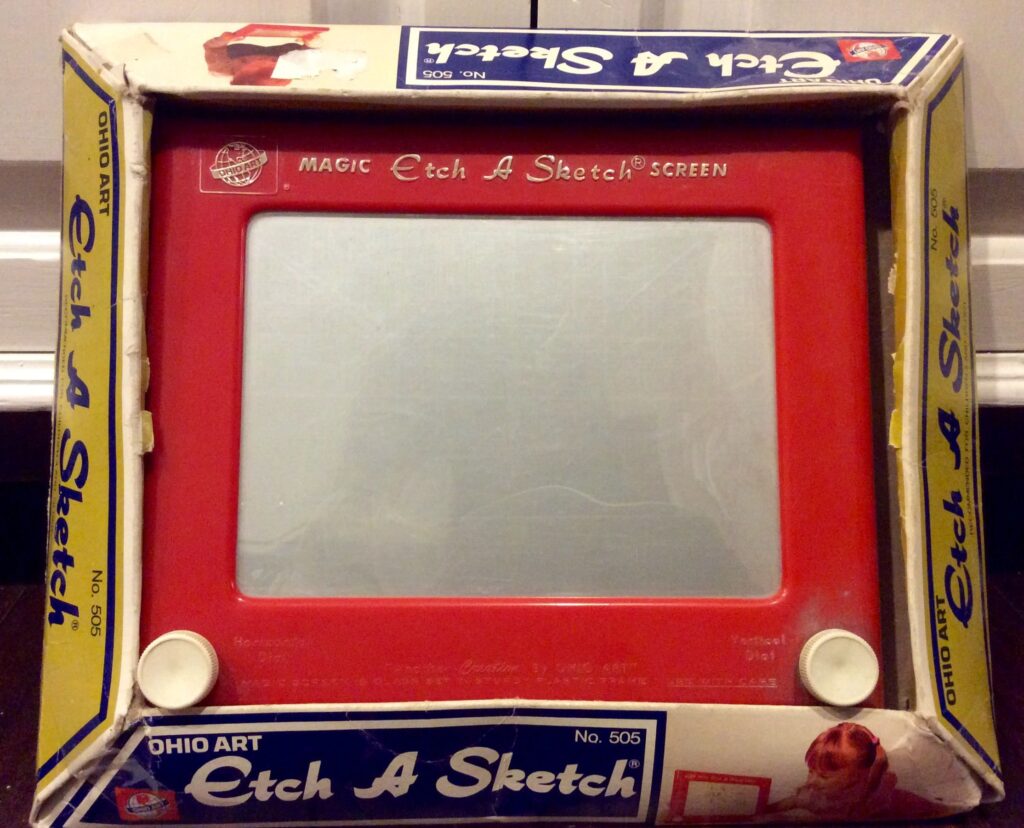
Playmobil
Playmobil é uma linha de brinquedos criada por Hans Beck (1929 – 2009) em 1974 e vendida mundialmente a partir de 1975. A linha consiste em pequenos bonecos com partes móveis e uma série de objetos, veículos, animais e outros elementos com os quais esses bonecos irão se integrar compondo uma série de cenários, sempre dentro de uma temática específica. Na Alemanha, são produzidos pelo grupo Brandstätter, sediado em Zirndorf. A empresa, fundada em 1876 por Andreas Brandstätter em Fürth, Baviera, inicialmente produzia cadeados. Em 1921, produzia principalmente brinquedos metálicos como porquinhos mealheiros, telefones e caixas registradoras. Em 1954, a produção mudou para artigos plásticos.
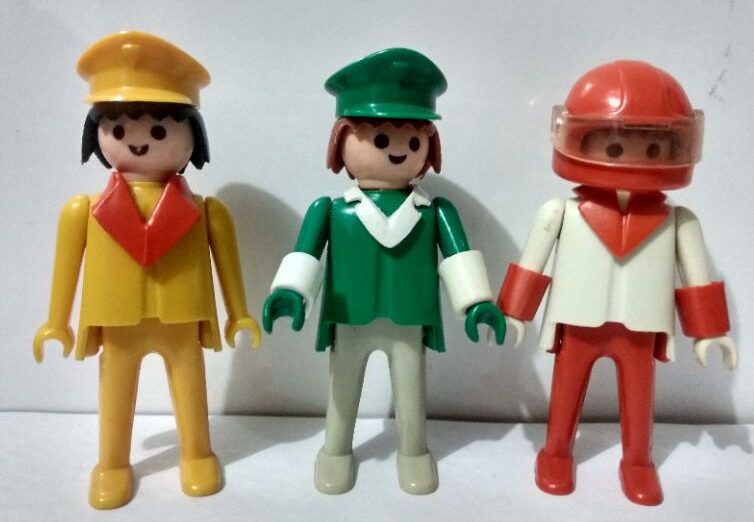
Playmobil
Playmobil is a German line of toys produced by the Brandstätter Group (Geobra Brandstätter GmbH & Co KG), headquartered in Zirndorf, Germany. The signature Playmobil toy is a 7.5 cm tall human figure with a smiling face. A wide range of accessories, buildings and vehicles, as well as many sorts of animals, are also part of the Playmobil line. Playmobil toys are produced in themed series of sets as well as individual special figures and playsets. New products and product lines developed by a 50-strong development team are introduced frequently, and older sets are discontinued. Promotional and one-off products are sometimes produced in very limited quantities. These practices have helped give rise to a sizeable community of collectors. Collector activities extend beyond collecting and free-form play and include customization, miniature wargaming, and the creation of photo stories and stop motion films, or simply as decoration.
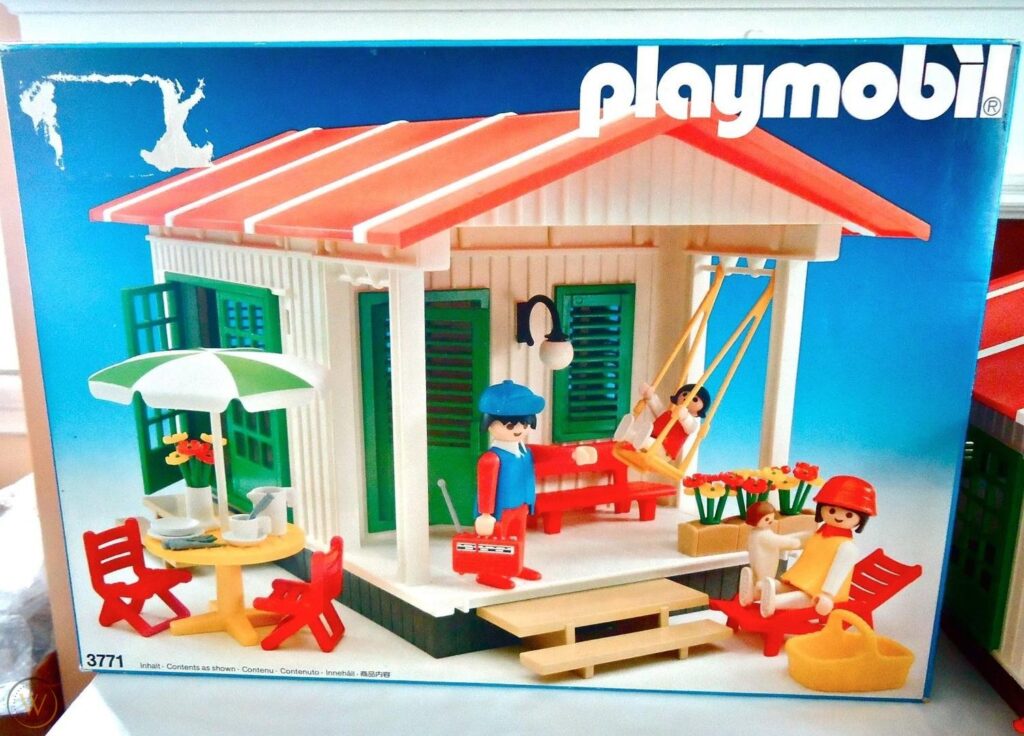 Pokémon Cards
Pokémon Cards
Pokémon é uma franquia de origem japonesa lançada em 1996 por Satoshi Tajiri e Ken Sugimori, cujo tema central envolve um mundo ficcional onde seres humanos convivem com criaturas de todas as formas e tamanhos denominadas Pokémon. A franquia estreou no vídeo game portátil da Nintendo – o GameBoy – com os jogos Pokémon Red e Pokémon Green, desenvolvidos pela Game Freak e rapidamente se expandiu para outras formas de entretenimento, como animação de televisão e brinquedos, entre eles, o Pokemon Cards.
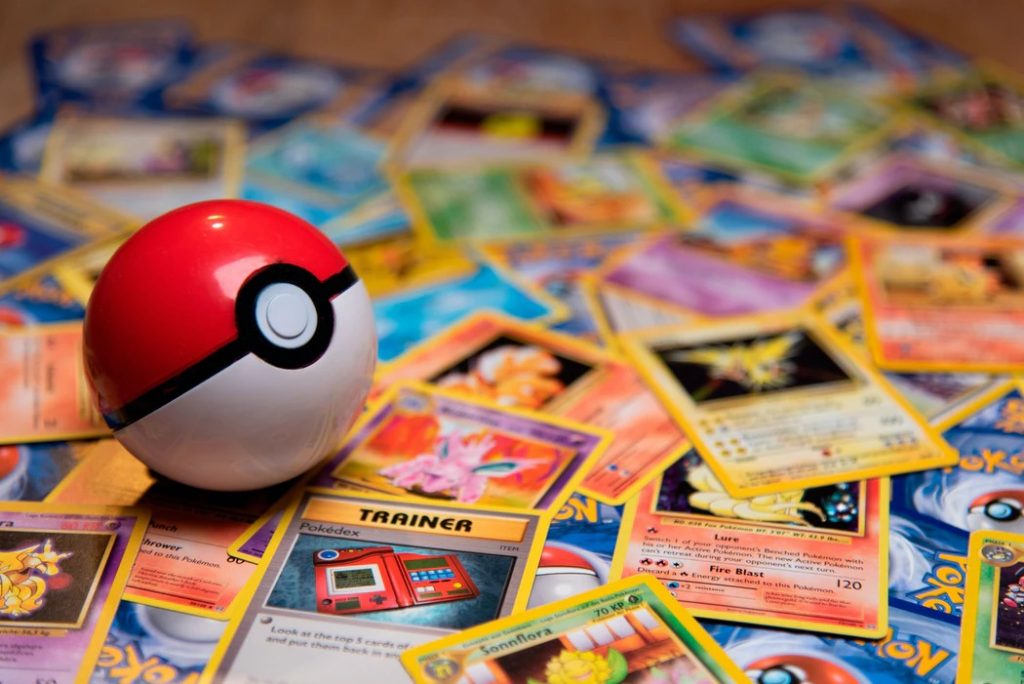
Pokémon Cards
The Pokémon Trading Card / Pokémon Card Game is a collectible card game based on the Pokémon franchise. It was first published in October 1996 by Media Factory in Japan. In the US, it was first published by Wizards of the Coast. In June 2003, Nintendo transferred the publishing rights from both Media Factory and Wizards of the Coast to The Pokémon Company. As of March 2022, the game has sold over 43.2 billion cards worldwide.
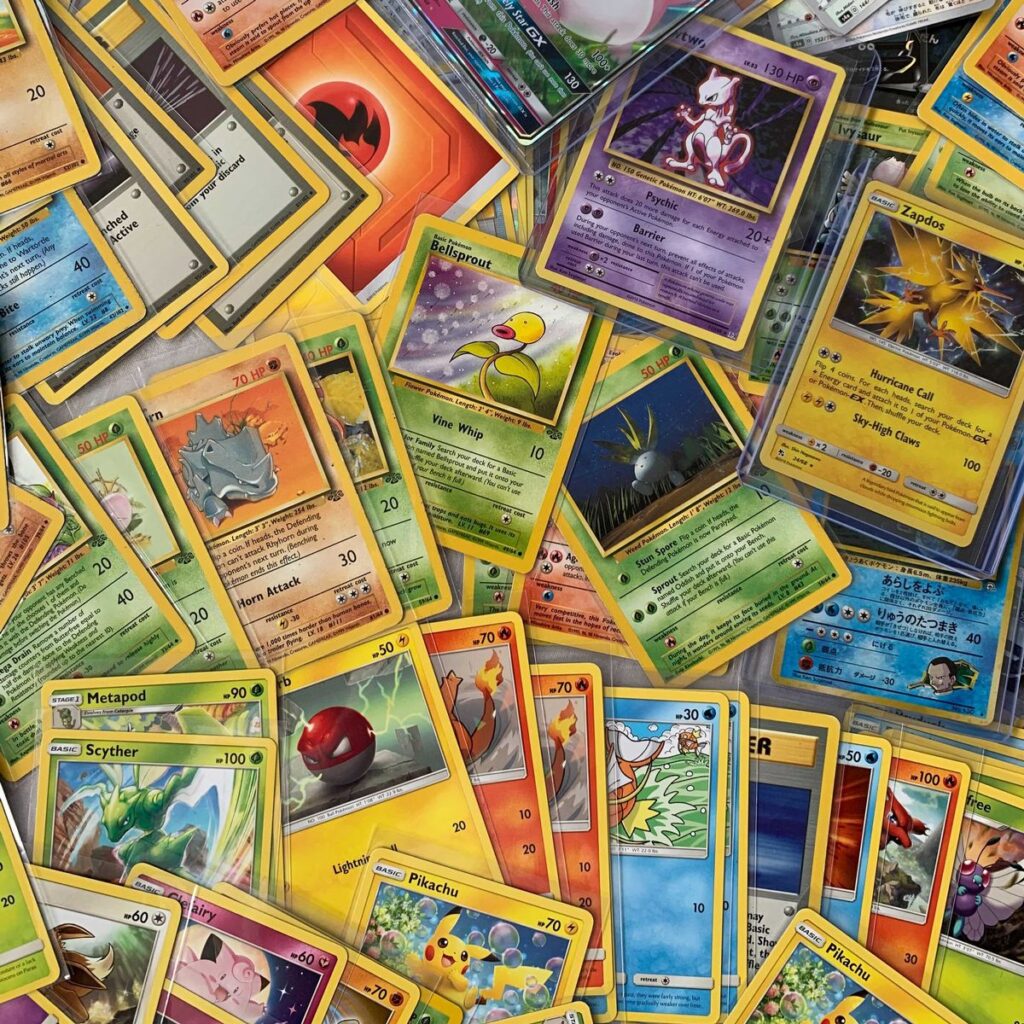 Sr. Cabeça de Batata
Sr. Cabeça de Batata
Você sabia que o Senhor Cabeça de Batata não é mais um senhor. Nem a Senhora Cabeça de Batata é uma senhora? A Hasbro, fabricante do popular brinquedo há quase 70 anos, decidiu alterar o nome de seus bonecos apenas para “Potato Head” (“Cabeça de Batata”, em tradução livre). Os brinquedos nas versões “Sr.” e “Sra.” seguem existindo, mas a franquia passa a ter o nome sem desinência de gênero.
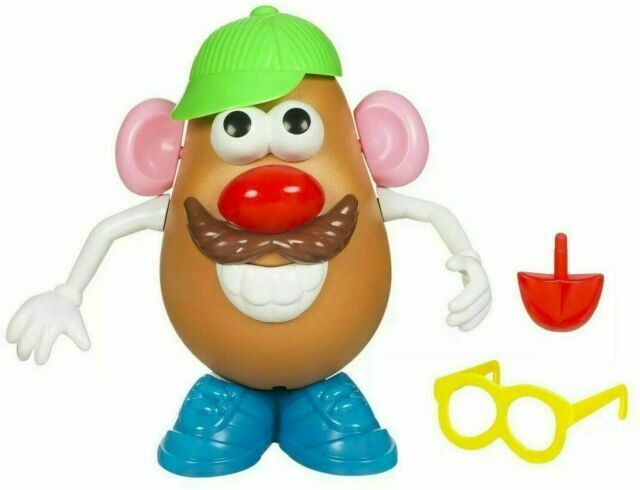
Potato Head
Mr. Potato Head is an American toy consisting of a plastic model of a potato “head” to which a variety of plastic parts can attach — typically ears, eyes, shoes, hat, nose, pants and mouth. Mr. Potato Head was invented and manufactured by George Lerner in 1949, but was first distributed by Hasbro in 1952, was the first toy advertised on television and has remained in production since.
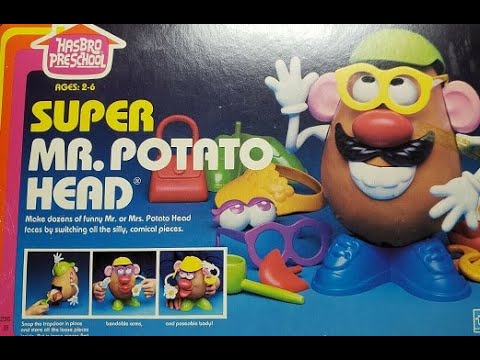 Pinos Luminosos
Pinos Luminosos
O brinquedo Pinos Luminosos / Lite-Brite era o máximo e fez sucesso em vários países do mundo nos anos 80 e 90. Era uma caixa de luz com pequenos pinos de plástico coloridos que se encaixam em um painel. Vinham 12 telas de desenhos para a criança preencher de acordo com as cores e 4 telas livres para os pequenos soltarem a imaginação. Depois da arte pronta, a caixa podia virar um abajur bem estiloso. Você se lembra?
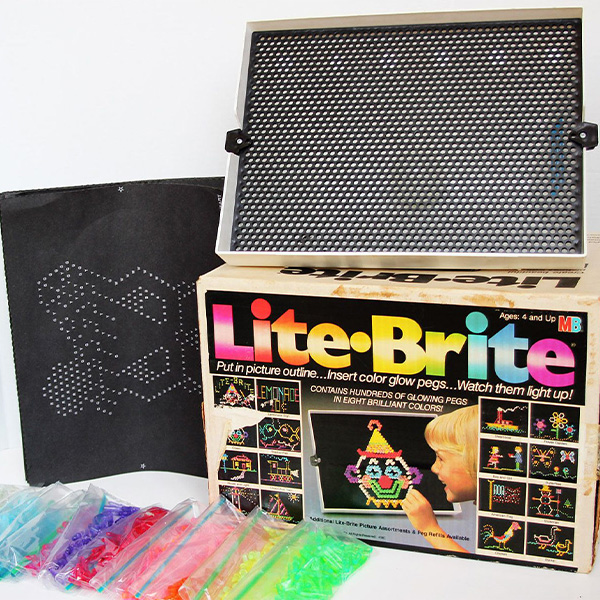
Lite-Brite
Lite-Brite is a toy that was originally marketed in 1967. It consists of a light box with small colored plastic pegs that fit into a panel and illuminate to create a lit picture, by either using one of the included templates or creating a “freeform” image on a blank sheet of black paper.
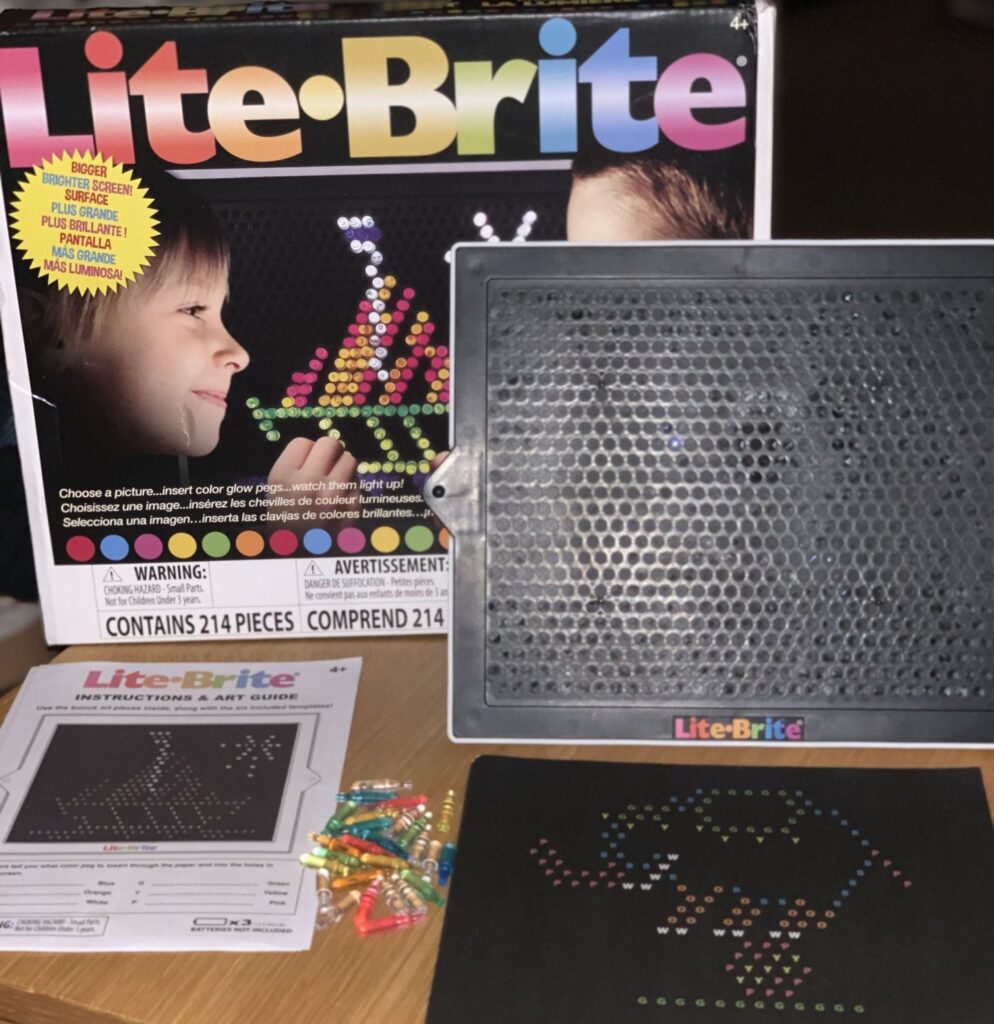 Confira os 10 brinquedos favoritos dos anos 80 e 90 votados pelos seguidores do @voceselembra.anos80
Confira os 10 brinquedos favoritos dos anos 80 e 90 votados pelos seguidores do @voceselembra.anos80
